


feel better–and




feel better–and
dad–knowing he can see his doctor at home.”
When getting to medical appointments becomes a challenge, Physician House Calls is here to visit you in the comfort and convenience of your own home.
From routine check-ups, to urgent appointments, medication review, care coordination and a 24-hour on call service, we offer a safe and secure option for homebound adults over age 65 seeking a primary care provider.
To find out more, call (585) 244-5993 or visit JSLPhysicianHouseCalls.org. A service of Jewish Senior Life

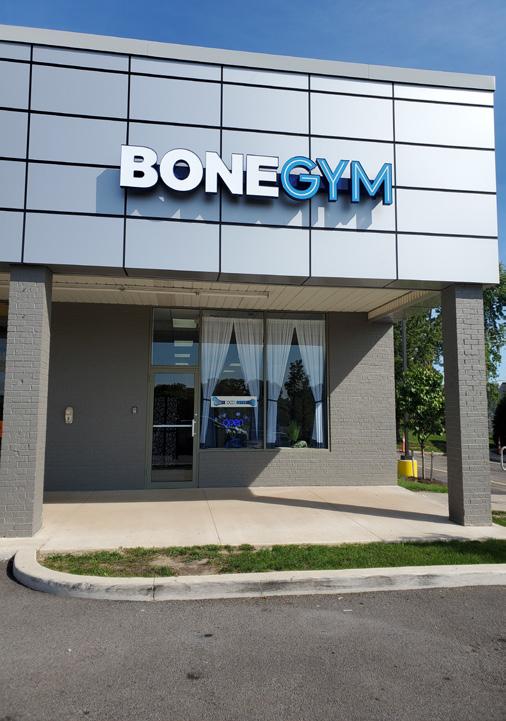
or Liz Lehmann, this is personal. Her grandmother had the classic dowager's hump, her mother is the incredible shrinking woman, and she's been battling Osteopenia for 15 years.
“Like many women, I kept looking for alternatives to the drugs,” said Lehmann.
Until she found this really interesting device, called a bioDensity machine, that strengthens bones naturally. It's similar to a workout machine for muscles in a gym, but it's optimized for bones.

As Lehmann explained, “The best you can do with weight-bearing exercises is about 1% increase in bone density. With the bioDensity machine
someone can reach up to 14% density increase per year, based on clinical studies. The results will vary, of course, depending on genetics, diet and your general health.”
The reason the bioDensity machine is so good at strengthening bones is because it's based on the science of osteogenic loading. (osteo bone; → genic producing → ) Since the 1880's, doctors have known that bones remodel themselves after a load is placed on them, known as Wolff's Law.
As it turns out, bones and muscles are similar and different – both have the use-it-or-lose-it process.
To build muscles you have to do
“The circuit is quick & simple. Everyone should find 15 minutes a week to build those bones!” ~ Amy
“This is a wonderful opportunity to help your bones without using drugs.” ~ Virginia
“Coming to the Bone Gym to help with my osteopenia has been great. Liz explains everything clearly.”
~ Madonna
long workouts a couple times a week and your muscles need a day or two to recover.
Bones, on the other hand, only require five seconds of stress and the recovery time is a week. But the stress needed to start the bone building process is multiple times a person's body weight. For a 130 lb woman, it would take about 550 lbs of force on the leg bones to make them stronger, which is not really possible at a gym.
15 minute “no sweat” Sessions
“What is unique about the bioDensity machine is that it isn’t doing anything to them,” Lehmann explained. “They’re pressing or pulling on the machine and it’s simply

Sessions are by
measuring their muscle efforts, and therefore how much stress is applied to their bones. People have complete control over their session. Plus, they don't sweat because it is so quick.”
During each session, a client tries to produce maximal force for five seconds in four different exercises: chest press, leg press, core pull, and vertical lift. The force would be similar to pushing or lifting an object of significant weight and size.
As a result, these exercises build stronger bones from the inside out by remodeling and strengthening the interior bone matrix – the way bones get stronger naturally.

It’s about more than just weight loss. It’s about reducing your risk for serious conditions like heart disease and diabetes — and regaining the stamina, mobility and confidence to take on every day.

Crouse’s bariatric surgery program offers a dedicated team of physicians and providers, as well as psychological and nutritional counseling — all with the expertise to support you every step of the way.


Begin the process from home by viewing our online informational video. Then consult with our bariatric team via telemedicine visits to start your journey. It’s time — and now easier than ever.
Start today at crouse.org/weightloss or call .

July-August 2023
Story ideas? Information about advertising? Email editor@roc55.com or call 585-421-8109.
•
40 MUSIC
• The Nightfall Bands: ‘It’s all about the love’
42 COVER STORY
• Vintage and antique hotspots along Route 20 in the Finger Lakes
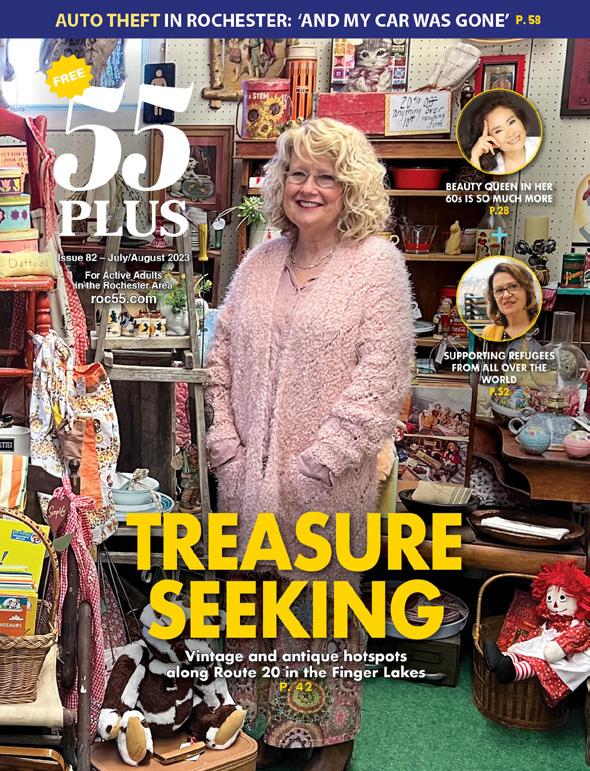
52 CHARITY
• Saint’s Place: Supporting refugees from all over the world
56 WINEMAKING

• From Tokyo, Japan, to Upstate New York: the varied life of Fumie Thorpe

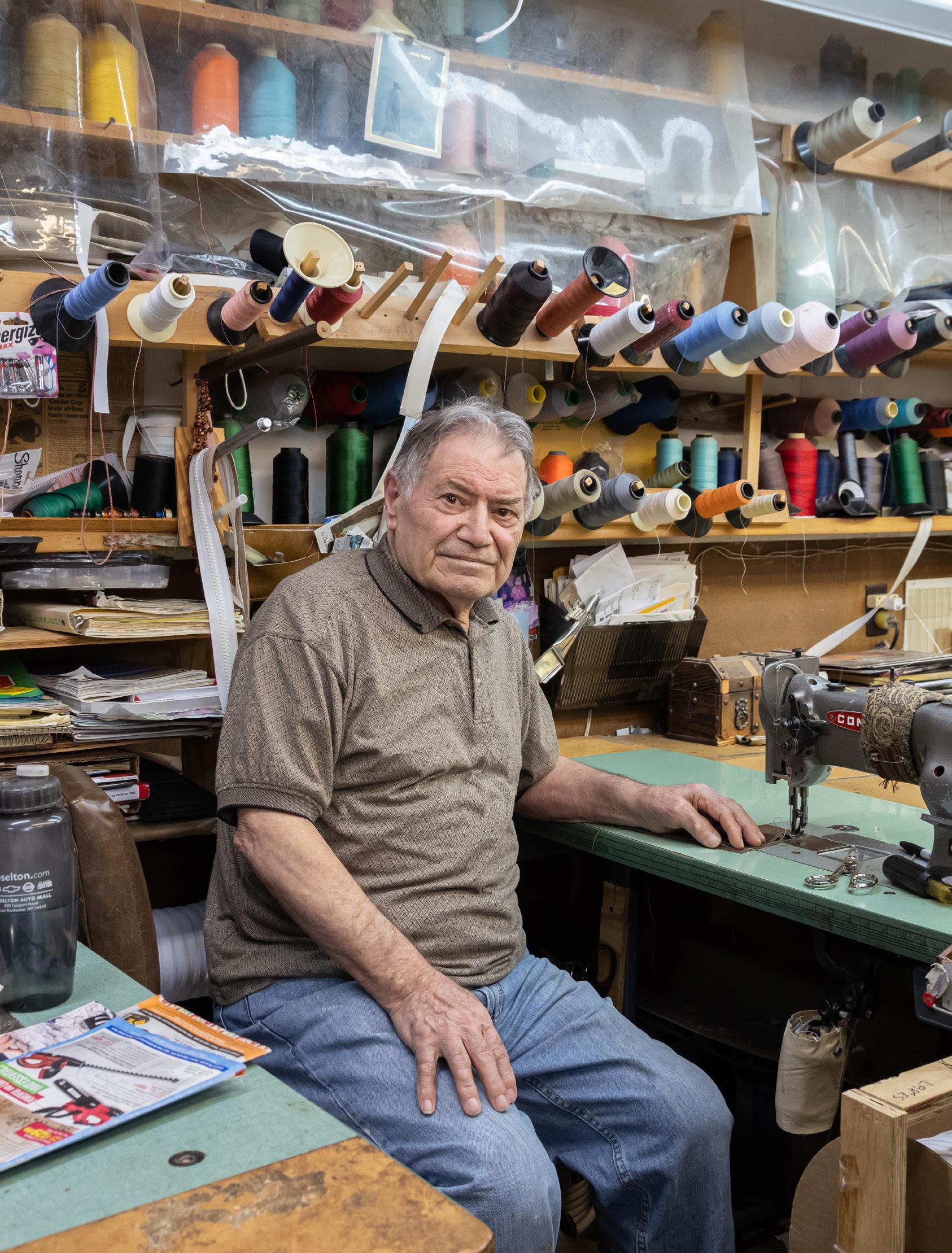


•
•
58 FIRST PERSON
• And my car was gone: Rochester’s car theft epidemic hits home
58 VISITS
• New York: A dairy cheesy state
•
Starting at $359,900

Located above Glass Factory Bay overlooking Seneca Lake, The Bay View Community is remote, yet accessible to city life. The 92- home planned neighborhood provides one-story homes, walking paths, ponds, and serene views. 4


Working part-time in retirement can be a terrific way to occupy your time and earn some extra income. The key, however, is finding the right gig that’s fun and satisfying for you. Here are a few possibilities to explore.
• Pet Services: If you love animals, consider pet sitting or dog walking. Pet sitters, who attend to a pet’s needs when their owner is away, can earn $15 to $40 per visit. Dog walkers can make $10 to $30 for a 30-minute walk.
To find these jobs, advertise your services in veterinarians’ offices or online at sites like Craigslist.org or Care.com. Or, if you’d rather work for an organization that offers these services, visit Rover.com.
• Teach or Tutor: Depending on your expertise, you could substitute teach or tutor students privately on any number of subjects. Substitute teachers typically make between $75 and $125/day, while tutors can earn between $15 to $30 per hour.
To look for substitute teaching positions, contact your local school district to see if they are hiring and what qualifications they require. To advertise tutoring services, use websites like Wyzant.com and Tutor. com.
Or, if you have a bachelor, master or doctoral degree, inquire about adjunct teaching at a nearby college or university.
• Drive: If you like to drive, you can get paid to drive others around using Uber or Lyft apps, or become a food delivery driver through Instacart or Uber Eats. Drivers make around $15 per hour.
• Babysit: If you like kids, babysitting can be a fun way to put money in your pocket. Hourly rates vary by location ranging anywhere from $10 to $40 per hour. To find jobs or advertise your services, use sites like as Care.com and Sittercity.com.
• Tour guide: If you live near any
historical sites or locations, national parks or museums (anywhere that attracts tourists), inquire about becoming a tour guide. This pays anywhere from $10 to $40/hour.
• Write or edit: Many media, corporate and nonprofit websites are looking for freelancers to write, edit or design content for $20 to $60 per hour. To find these jobs try FreelanceWriting. com, FreelanceWritingGigs.com and Freelancer.com.
• Consult: If you have a lot of expertise in a particular area, offer your services as a consultant through a firm or on your own through freelancer sites like Upwork.com, Fiverr.com, Freelancer.com or Guru.com.
• Translator or interpreter: If you’re fluent in more than one language you can do part-time interpretation over the phone or translate documents or audio files for $20 to $40/hour. Try sites like Translate.com, ProZ.com or Gengo.com to locate translation jobs.
• Public events: Sporting events, festivals, concerts and shows need ticket takers, security guards, ushers, concession workers and more. The pay is usually $10 to $20/hour. Contact nearby venues to apply.
• Tax preparer: If you have tax preparation experience or are willing to take a tax prep course you can find seasonal work preparing tax returns at big-box tax firms like H&R Block or Jackson Hewitt for around $17/hour.
• Bookkeeper: If you have a finance or accounting background you can find freelance bookkeeping gigs at sites like Upwork.com and Fiverr.com, or through firms like BelaySolutions.com.
• Librarian assistant: If you love books, public libraries hire part-time workers to shelve books, send out overdue notices, help patrons, etc. Contact your local library to see what’s available.
If you don’t find these options appealing, try FlexJobs.com, which lists thousands of work-at-home jobs from more than 5,700 employers.
roc55.com
Editor and Publisher
Wagner Dotto
Associate Editor
Stefan Yablonski
Writers & Contributors
Deborah J. Sergeant, John Addyman Melody Burri, John Csiszar
Mike Costanza, Donna Jackel Columnists

John Addyman, Laurie Haelen Jim Miller
Advertising
Anne Westcott • 585-421-8109 anneIGHsales@gmail.com
Linda Covington • 585-750-7051 lindalocalnews@gmail.com
Office Manager Allison Lockwood
Layout & Design Angel Campos-Toro
Cover Photo Melody Burri
55 PLUS – A Magazine for Active Adults in Rochester is published six times a year by Local News, Inc. at PO Box 525, Victor, NY 14564, which also publishes In Good Health — Rochester's Healthcare Newspaper.
Subscription: $21 a year; $35 for two years
© 2023 by 55 PLUS – A Magazine for Active Adults in Rochester. No material may be reproduced in whole or in part from this publication without the express written permission of the publisher.
P.O. Box 525
Victor, NY 14564
Phone: 585-421-8109
Fax: 585-421-8129
Email: editor@roc55.com
Editor@cnyhealth.com

Our Pittsford location is Audubon Certified and a Level 1 Arboretum. Our park-like setting will provide peace & comfort while you visit.




Our Canandaigua Lakeview Cemetery sits on quiet hillside on the east side of the lake. It offers the most serene and intimate location for you to reflect on your loved one.
We have a wide variety of settings and a full range of options for both full casket and cremation burials. Throughout all of our Park you will find large mature trees, colorful gardens and many places to sit, reflect and connect with your loved ones.

The Basin Pond is our newest addition to The Nature Trail. These cremation sites are in a peaceful & natural setting. The centerpiece is a man-made pond with a tranquil fountain in the middle. This area is nearing completion. Call to schedule your tour today.

We have several mausoleum buildings to choose from and they each have their own unique features and styles. You can choose a crypt, niche or even a combination crypt. We have many inside or outside locations available.

210 Marsh Road
Pittsford, NY 14534
585.586.5250
www.whitehavenmemorialpark.com
By Laurie HaelenAs I get the opportunity to talk with clients and friends in our social circle, one common theme regularly emerges: Social Security.
A recent Gallup survey found that more than 90% of Americans worry about the Social Security program, and about half of those said they worry a great deal. A separate survey the same month found that more than 80% of Americans worry Medicare will not be able to provide the same level of benefits in the future, according to the Kaiser Family Foundation.
These concerns are well-founded, because both programs — the cornerstones of "America's safety net" — face serious fiscal challenges that require congressional action. The longer Congress waits to act, the more extreme the solutions will have to be. Even so, it's important to keep in mind that neither of these programs is in danger of collapsing completely. The question is what type of changes will be required to rescue them.
The fundamental problem facing both programs is the aging of the American population.
Today's workers pay taxes to fund benefits received by today's retirees, and with lower birth rates and longer life spans, there are fewer workers paying into the programs and more retirees receiving benefits for a longer period of time. In 1960, there were 5.1 workers for each Social Security beneficiary; in 2023 there are 2.7, dropping steadily to 2.2 by 2045.
Payroll taxes from today's workers, along with income taxes on Social Security benefits, go into interest-bearing trust funds. During times when payroll taxes and other income exceeded benefit payments, these funds built up reserve assets. But
now the reserves are being depleted as they supplement payroll taxes and other income to meet scheduled benefit payments.
Each year, the trustees of the Social Security and Medicare Trust Funds provide detailed reports to Congress that track the programs' current financial condition and projected financial outlook. These reports have warned for years that the trust funds would be depleted in the not-toodistant future, and the most recent reports, both released on March 31, suggest that the future may arrive even sooner than expected.
Social Security consists of two programs, each with its own trust fund. Retired workers and their families and survivors receive monthly benefits under the Old-Age and Survivors Insurance (OASI) program; disabled workers and their families receive monthly benefits under the Disability Insurance (DI) program.
The OASI trust fund reserves are projected to be depleted in 2033, one year earlier than in last year's report, at which time incoming revenue would pay only 77% of scheduled benefits. Reserves in the much smaller DI trust fund, which is on stronger footing, are not projected to be depleted during the 75-year period ending 2097, according to the Social Security trustees report.
Under current law, these two trust funds cannot be combined, but the trustees also provide an estimate for the combined program, referred to as OASDI. This would extend full benefits another year, to 2034, at which time, incoming revenue would pay only 80% of scheduled benefits, according to the trustees report.

Therefore, the current outlook suggests that Social Security beneficiaries might face a benefit cut
of 23% in a decade unless Congress takes action.
Medicare also has two trust funds. The Hospital Insurance (HI) trust fund pays for inpatient and hospital care under Medicare Part A. The Supplementary Medical Insurance (SMI) trust fund comprises two accounts: one for Medicare Part B physician and outpatient costs and the other for Medicare Part D prescription drug costs.
The HI trust fund reserves are projected to be depleted in 2031. This is three years later than in last year's report, due to lower costs and higher payroll taxes, but still more imminent than the Social Security shortfall. At that time, revenue would pay only 89% of the program's costs, states the 2023 Medicare Trustees Report.
The SMI trust fund accounts for Medicare Parts B and D are expected to have sufficient funding because they are automatically balanced through premiums and revenue from the federal government's general fund, which provides about 75% of costs, a major outlay from the federal budget, according to the Medicare Trustees Report.
The trustees of both programs continue to urge Congress to address these financial shortfalls soon, so that solutions will be less drastic and may be implemented gradually.
Any permanent fix to Social Security, say Social Security Administration officials, would likely require a combination of changes, including some of these:
• Raise the Social Security payroll tax rate (currently 12.4%, half paid by the employee and half
The current outlook suggests that Social Security beneficiaries might face a benefit cut of 23% in a decade unless Congress takes action
by the employer). An immediate and permanent payroll tax increase to 15.84% would be necessary to address the long-range revenue shortfall (or to 16.55% if the increase started in 2034).
• Raise the ceiling on wages subject to Social Security payroll taxes ($160,200 in 2023).
• Raise the full retirement age (currently 67 for anyone born in 1960 or later).

• Change the benefit calculation formula.
• Use a different index to calculate the annual cost-of-living adjustment.
• Tax a higher percentage of benefits for higher-income beneficiaries. Options for reducing the Medicare shortfall include a combination of spending cuts and tax increases, recommends the Committee for a Responsible Federal Budget. These are some possibilities:
• Improve the payment system for Medicare Advantage Plans (private plans that receive partial funding from Medicare).

• Modernize cost sharing between Medicare and Medigap (supplementary insurance).
• Increase the Medicare payroll tax rate (currently 2.9%, shared equally between employee and employer, with an additional 0.9% on income above $200,000 for single filers and $250,000 for joint filers).
• Broaden the tax base subject to Medicare payroll taxes (there is no income ceiling for Medicare payroll taxes, but certain income is currently not subject to the tax).
Based on past changes to these programs, it's likely that any future changes would primarily affect future beneficiaries and have a relatively small effect on those already receiving benefits. While neither Social Security nor Medicare is in danger of disappearing, it would be wise to maintain a strong retirement savings strategy to prepare for potential changes to America's safety net.
All projections are based on current conditions, subject to change, and may not come to pass.
Laurie Haelen, AIF (accredited investment fiduciary), is senior vice president, manager of investment and financial planning solutions, CNB Wealth Management, Canandaigua National Bank & Trust Company. She can be reached at 585-419-0670, ext. 41970 or by email at lhaelen@cnbank.com.
I’m Charles Bearce, a licensed sales agent in Western NY. When it comes to Medicare, it’s important to consider all of your options. What works well for your neighbor may not be the best fit for you. I know the ins and outs of Medicare, and I’m ready to answer your questions and help you find a plan that fits your needs.

69
bearcemed@gmail.com
www.MyUHCagent.com/charles.bearce
 By John Csiszar
By John Csiszar
Many Americans don’t really know where to turn to get financial advice, and that’s completely understandable. Financial literacy courses, although on the rise, are not yet generally a part of the core curriculum at many schools. This leaves many adults underprepared when it comes to handling their money.


As a result, many turn to the internet or other media-based sources. According to a recent survey by GOBankingRates, more than 47% of respondents indicated they take financial advice from influencers and personalities on social media, TV-


radio- and podcast-personalities or other financial experts in the media at least some of the time. With this approach, many people could be missing out on valuable expert advice. This begs the question, how can you decide who is worth listening to and who isn’t? Here are some options to consider when you make that decision.
• Look for Credentials — Just like you wouldn’t go to a doctor without a medical license, it’s not usually a good idea to entrust your finances to someone without accreditation. Exactly what type of qualifications you should look for depends on you.









Some investors only want to get advice from trained experts with certifications like the certified financial planner (CFP) designation or a chartered financial analyst (CFA) accreditation. Others prefer experts with more real-world experience than academic qualifications.

The important thing is that you don’t fall into the trap of listening to financial advice that is sensationalized or part of a marketing plan. In other words, be wary of YouTubers and Reddit “experts” who claim to have made millions of dollars from day trading or buying cryptocurrencies. While it’s possible this may have


happened, it’s not the basis of a longterm wealth creation plan.
• Find Experts With a Proven Track Record — Regardless of the credentials of a media expert, you’ll only want to take advice from someone who has a demonstrable record of success. In other words, it’s all well and good for someone to say they have a financial road map that will lead you to untold riches, but unless they can back up their assertions with verifiable, realworld data points, you might want to give their advice a pass.
This doesn’t mean you should only listen to advice from millionaires, but it does mean that you should see evidence that the information you’re hearing has paid real-world dividends.
• Seek Someone With an Understanding of Your Personal Situation — Since financial advice in the media tends to be generic, you’ll want to look for someone with experience that’s relatable to your personal situation. For example, the financial advice you want to listen to may vary based on what sex you are, whether or not you are working, your age, your marital status or other variables.
Someone with a low income and five children, for example, might want to follow a different expert than a millionaire with international real estate holdings and multiple businesses.

• Get a Second Opinion — and a Third One — No one has all the answers in the financial world — otherwise, everyone would just use the same playbook and their financial worries would be over. The truth is that financial planning is part art and part science.
While the most basic concepts will always be helpful — have an emergency fund, save as much as you can, don’t get emotional about investments and so on — even experts can have different opinions about how to implement a financial plan. This is why it’s always a good idea to crosscheck advice you plan on taking with how others view it. While two or three different financial personalities might not agree, you should be able to draw some wisdom from how and why they differ as well.

• Take Everything With a Grain of Salt — At the end of the day, no one
is going to care more about your personal financial situation than you. Although experts often give sound financial advice, almost by definition it has to be generic in nature. Financial personalities in the media are looking to build the biggest audiences they can, not just to reach the most people with their advice but also to earn the most money. With that in mind, understand that solutions you hear in the media may work for you on a general level, but you’ll have to tailor them to your specific needs.
The bottom line is that everyone’s personal financial situation is unique, so the best approach is generally to take bits of advice that apply specifically to you from a variety of sources. Just like you’d never want to put all of your nest egg into a single investment, you shouldn’t generally source advice from just a single person — and you should always do at least a little of the legwork yourself.

This article was published by GOBankingRates.com. Reprinted with permission.
As a couple, we will be romantic, committed, and grateful. I am a gentleman first and foremost. I am comfortably retired in my home. Others have described me as loyal, gracious, and well dressed. The woman of my dreams will be in her seventies, fit, and someone I can be proud to be with. Her strength will be joie de vivre. Users of cigarettes, alcohol, drugs, and tattoos need not apply.

If you are the woman of my dreams, please reply to K23h45@duck.com with age, bio, recent photos and contact info.

Rohrbach Brewing Co. has a lot to uphold. It confidently boasts itself as Rochester’s first craft brewery, the establishment pulled from Western European tradition as its starting point.
The brewpub on Buffalo Road in Rochester has no qualms about what the company has going for itself, save the two locations and a distinctive line of familiar beers shoppers have seen stocked on shelves, from its rich malty Scotch ale to the bright and hoppy Space Kitty.
How can anyone forget a beer donning a cat wearing a space helmet?
Aside from clever, whimsical beer names and cans, Rohrbach takes itself seriously on all fronts. Speaking of front, the first impression of the brewpub was warm and clean. Add a friendly staff, especially one accommodating to a 10-month-old and a service dog in training, and the experience is off to a great start.
Of course, we had to order beer by the flight ($10 each). There are too many to go through without going on a tangent, but IPAs Different Animal
and Bathed in Light really stood out.
Separate from the bill, a four-pack of Bathed in Light, a New England IPA with bright notes of citrus and pine, came home with the leftovers.
Plus, instead of the five-ounce tasting glasses, Rohrbach’s glasses are generously more, so there is more to enjoy with a standard price for flights.
An easy sell was the tacos because of the “Taco Tuesday” special (three tacos for $11). There are more than a handful of tacos to choose from with the ability to mix-and-match.
The fish taco with golden-fried

haddock and slaw was the brightest and lightest of the trio. It was a large, full taco but the fish and the ingredients came across like a beachside treat. The General Tso chicken taco packed a spicy kick a fan would hope for. The heavy-duty garbage plate taco, well, is what you’d expect. The flour taco shell cradled ground beef, macaroni salad and mustard; a sample for the garbage-plate-wary and just enough to satisfy a craving.
The knockwurst and pierogies ($22) came with one of the former and five of the latter, a heap of sauerkraut, sour cream and mustard, and a requirement to share. The bulging potato pierogies with the link of pork and veal added to a memorable trifecta with the kraut. The kraut wasn’t overly sour, but didn’t short on flavor and is one of my favorite takes on the dish.
We enjoyed it but our kiddo scarfed down what we gave her. As much of a mutt in terms of nationality, she allowed her German roots through. She tried reaching for the beers, too, but we had to push those farther away.
The State Street schnitzel ($22) came prepared two ways: the jäger with mushroom gravy or schwarzwarld with ham and beer cheese. Either came with spätzle, German egg noodles
similar to yet distinct enough from the smaller and harder distant cousin gnocci and more sauerkraut.
Two large and flattened and crispy-breaded pork cutlets were the focus of the jägerschnitzel. The pork was incredibly tender. The mediumthick mushroom gravy blanketing the meat added to the dish with a rich and slightly salty punch.
Last but not least: the Kaffee brisket plate ($23), which is designated as a pub favorite. Coffee-rubbed tender, melt-in-your-mouth brisket came slathered in the similar brown gravy as the schnitzel. The end of the brisket had my wife and I looking at each other almost skeptically, but don’t judge the brisket by the ends.

The light and dense potato pancake was a welcomed option and it paired well with the meat. Add in a piece of the roasted apple, and this becomes a dream. The fruit was roasted just right, boasting a subtle smokiness and maintaining a crunch to the bite.

Before tip, the bill came to just over $100 and we left with a lot of leftovers.
I don’t want to say there were high expectations for Rohrbach, but there was a lot of excitement leading up to enjoying a visit. It didn’t disappoint in many regards.

3859 Buffalo Road Rochester, NY 14624
585-594-9800
Sunday: noon – 9 p.m.
Monday: 11 a.m. – 9 p.m.
Tuesday – Thursday: 11 a.m. – 11 p.m.

Friday: 11:30 a.m. – midnight Sat.: noon – midnight
97 Railroad St. Rochester NY 14609
585-546.8020
Sunday – Tuesday: Closed
Wednesday – Friday: 4 – 10 p.m.
Saturday: 10 a.m. – 10 p.m.
facebook.com/Rohrbachs instagram.com/ rohrbachbrewingco
LEFT TO RIGHT: Knockwurst and pierogies, $22; Beer by the flight at Rohrbach Brewing Co.: $10 each; Kaffee brisket plate ($23), which is designated as a pub favorite.
Prepared home-delivered meals have become a booming business. But it was during COVID-19 when sales really skyrocketed, as restaurants and other eateries were forced to shut down.
According to Grandview Research, a market-research firm based in San Francisco, the global meal delivery services market was valued “at $15.21 billion in 2021 and is expected to grow

17.4% from 2022 to 2030.”
One reason is that these homemade meals are less expensive than takeout food, according to the research company.



Shaina Sidoti of Rochester was ahead of the curve. She founded Effortlessly Healthy in 2013. Sidoti had taken a bit of a gamble. Without any cash reserves, she quit her job as an administrative assistant to start her
food delivery business.
“People were telling me they didn’t have time to eat healthy,” she said.
The doors opened at a warehouse on Emerson Street. There were three employees, including Sidoti and her mother. After outgrowing several spaces, two years ago the business moved to 1440 Scottsville Road. Sidoti now has 25 employees and revenues of
about $2.5 million.
Effortlessly Healthy delivers fresh meals twice a week to Rochester homes. People can order between five and 21 meals at a time. Customers also have the option to pick up meals at the store.
“It’s a subscription service,” Sidoti said. “Everything is ordered in advance. The menu changes weekly so people don’t get bored.”
Meals can be catered to one’s dietary needs, such as low sodium, diabetic friendly and gluten free.
Some of the dishes offered are chicken parmesan, pizza egg bake, Asian stir fry, salads, wraps and vegetarian roasted butternut squash salad.
“It’s just good, healthy food that’s made fresh locally,” Sidoti said.
Out of hundreds of clients, she estimates about half are 55 and older.
In addition to the home deliveries, Effortlessly Healthy operates a food truck, serves as the preferred caterer for the University of Rochester Medical Center and, through Medicaid, provides meals at several senior living facilities.
One of the other home meal delivery businesses in Rochester is 95Nutrition. It was founded in Buffalo in 2015 by Lindsey and Carmelo Cruz. In January 2022, they expanded to Rochester and now have four locations in Victor, Greece, Henrietta and Rochester.


“I always had a passion for food and we didn’t have anything like this in Buffalo,” said Lindsey Cruz, adding that all the meals are made in house.
While many customers use 95Nutrition to lose weight, others like the convenience, she said. Customers
Shaina Sidoti of Rochester founded Effortlessly Healthy in 2013. She had three employees at the time, including her and her mother. She now has 25 employees and revenues of about $2.5 million.

have the choice of ordering small or large portions. The meals are made onsite and then frozen “to keep them fresh as long as possible.”
The business delivers meals from 12 locations and also ships nationwide, Cruz explained. She estimates that
about 30% of her customers are 55 and older, while others are seeking a work-life balance.
“Now, more than ever, people want to spend time with their family, not in the kitchen,” she said. “And with grocery costs skyrocketing, you can save more than you think with prepared food, while still getting variety.”
Their meals include blueberry protein pancakes for breakfast, beef and broccoli and coconut shrimp.
But convenience is not the only benefit to having meals delivered to your home. The service also offers an opportunity for seniors to socialize with the delivery person and gives caregivers peace of mind knowing that their loved ones are regularly receiving healthy meals.
According to a 2022 study published in the National Library of Medicine, home-delivered meals “not only provide improved nutrition, but also offer regular social contact for older adults, which can increase feelings of safety experienced by meal recipients.”
And, in a 2019 National Survey of Older Americans Act participants, 85% of meal recipients reported feeling safer because of the delivery visits.

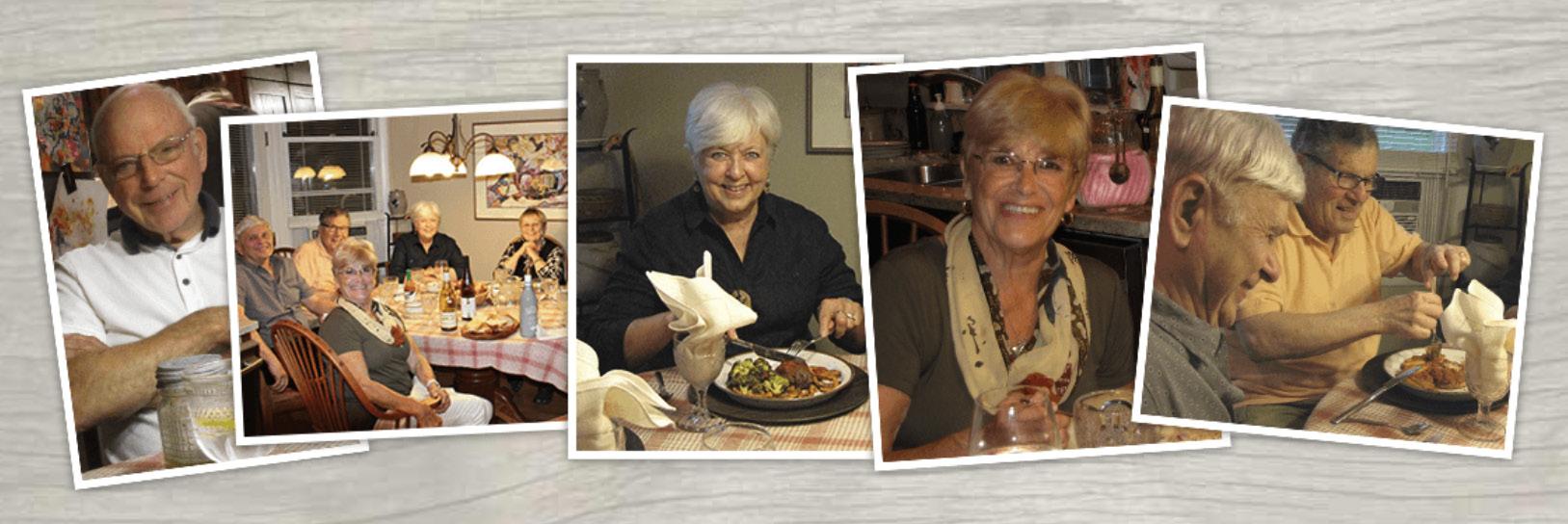

Make this the year you make your flowerbeds the star of the neighborhood by planning for color all season long.

Suzanne Feather, master gardener with Monroe County Cooperative Extension, said that homeowners should adopt the Extension expression “right plant, right place.”
“Before your run out to the garden center, observe your sun and shade,” she said. “Have your soil tested so you can know if you need amendment. We recommend samples from various parts of the yard.”
Extension offices will test the soil
pH and nutrients for $10 a sample. This can help save money by using the correct amendments only as needed and prevent the mistake of planting the wrong plant in the wrong place. Selecting plants relies upon more that the soil. Most plants prefer full sun, partial sun or full shade.
“The care tag itself gives you the placement,” said Laura Vendel, co-owner of Welch's Greenhouses in Webster. “It tells the height of the plant, spacing and when it will bloom. Get a garden book to read about the tricks of gardening and pruning so you know how to take care of it before you buy.”
The height and spacing of plants
are important because you don’t want plant something that will become tall or bushy next to a smaller, shorter plant. Competition for light and water is one way to complicate flower gardening.
Vendel advised planting shorter plants in the front, middle height plants in the middle and taller plants in the back.
She advises starting with flowering shrubs and then filling in with perennial plants and then annuals.
“Mix perennials with annuals so you have continual blooming from the annuals and with the perennials, you won’t have to purchase every
year,” Vendel said. “It’s a little more affordable and less work.”
Preparing the area with a weed mat can help suppress weeds, both improving the appearance of the flowerbed and minimizing competition with weeds. Vendel advised using three inches of hardwood mulch — it breaks down more slowly than other kinds — on top of the mat to further suppress weeds, augment the appearance and maintain moisture in the flowerbed.
Samantha Mills, business partner at Stem in Rochester, said that to save money, corrugated cardboard or newspaper may be used as a weed barrier under mulch.
“You don’t have to dig through weed fabric the next year,” she said. “But don’t use shiny magazine paper.”
She likes to “bulb stack” by layering later bulbs like tulips deeper in the soil, followed by daffodils and then early bulbs like crocus to keep the spring color going.
“Planting fast-creeping annual is a good way to help with weed suppression,” Mills added. “Petunias, snapdragons, foamy bells, snow-insummer, candy tuft and decorative grasses are a good way to do that.”
It’s easy to see flowers in a catalog or online that look amazing and try to replicate the look. However, they may not be plants well-suited to the local climate.
“Go to the garden center and see what’s blooming, said Brenda Sunseri, lead designer at Birchcrest Tree & Landscape in Rochester. “Don’t just focus on flowers but look for colorful foliage, things with winter interest, like plants and trees with persistent fruit like colorful berries. Holly would be an example, as are some crabapples. There are lots of plants that have colorful things that aren’t flowers.”
She also likes to include elements that attract colorful wildlife, such as a birdbath, birdfeeder, hummingbird feeder and plants that appeal birds and pollinators.
Butterfly bush draws butterflies and trumpet honeysuckle or any red flowers attract hummingbirds.
Sometimes, Sunseri plans an entire garden with a variety of flowers around a single color, such as white, which many people find soothing.
“Window boxes can hold your flowers and can be colorful,” Sunseri said. “Don’t be afraid to be bold. Not everything can be a focal point.”
Full sun to partial sun
Petunia (Proven Winner variety)
Petunia (Wave variety), Geraniums

Ageratum
Lantana
Marigolds
SunPatiens
Angelonia

Truffula
Straw Flower
Cleome
Zinnia
Salvia
Early perennial flowers
Helleborus
Dianthus
Primrose
Candy tuft
Forget-me-nots
Phlox
Midseason flowers include:

Shasta daisies
Daylilies
Hosta

Bee balm
Russian sage
Lavender
Shade loving plants
Torenia (wishbone flower)
Impatiens
Browallia “They’re amazing; I put one in a big flowerpot on the porch in the shade, and it’s gorgeous,” Schuetz said.
Coleus
Lobelia
Hostas
Wax begonia
Heliotrope
Nonstop begonia
Late season perennials:
Black-eyed Susan
Asters
Hibiscus

Anemone
Chrysanthemum
Some of the suggestions above were made by Gloria Schuetz , gardener at Bauman's Farm Market in Webster and Dennis Keady, general manager at Garden Factory Inc. in Rochester.
Whether you’re interested in dating again or just looking for a friend to spend time with, online dating sites and apps have become an easy and convenient way for older adults to meet new single people without ever having to leave home.

And to make things even easier, most sites today use matchmaking algorithms that factor in your interests and preferences so they can steer you to matches that are best suited for you. Here are some other tips to help you get started.
There are dozens of different matchmaking websites and apps available today, so choosing can be a bit confusing.
While many sites offer free trials or watered-down free content, finding out the price can be difficult until you register and provide some information.
In general, viewing complete profiles and messaging potential dates will require a monthly fee, which can range anywhere between $10 and $40 per month.
Some top mainstream sites and apps that are popular among older adults are eHarmony.com, Match.com and OKCupid.com. If, however, you’re interested in more age-specific sites,
some great options are OurTime.com or SilverSingles.com.
Or if you have a specific kind of person you’d like to meet, there are dozens of niche sites like: EliteSingles. com for educated professionals; ChristianMingle.com for Christian singles; BLK-app.com for black singles; JSwipeApp.com for Jewish singles; and Facebook.com/dating for people who love Facebook.
When you join a matchmaking site, you’ll need to create a personality profile that reflects who you are, including recent photos, hobbies, interests, favorite activities and more. If you need some help, sites like ProfileHelper.com can write one for you for a fee.
When you register with a site you remain anonymous. No one gets access to your personal contact information until you decide to give it out, so be prudent to whom you give it. Before meeting, you should chat on the phone or video chat a few times, and when you do meet in person for the first time, meet in a public place or bring a friend along. And if someone asks for money or your financial information,
don’t give it out. Online dating and sweetheart scams are rampant so be very cautious.
In an effort to get more responses, many people will exaggerate or flat out lie in their profiles, or post pictures that are 10 years old or 20 pounds lighter. So, don’t believe everything you see or read.
A lot of times, people — especially women — sit back and let others come to them. Don’t be afraid to make the first move. When you find someone you like, send a short note that says, “I really enjoyed your profile. I think we have some things in common.” Keep it simple.
If you don’t get a response from someone, don’t let it bother you. Just move on. There are many others that will be interested in you and it only takes one person to make online dating worthwhile.
Jim Miller is the author of Savvy Senior, a column published every issue in 55 PLUS.


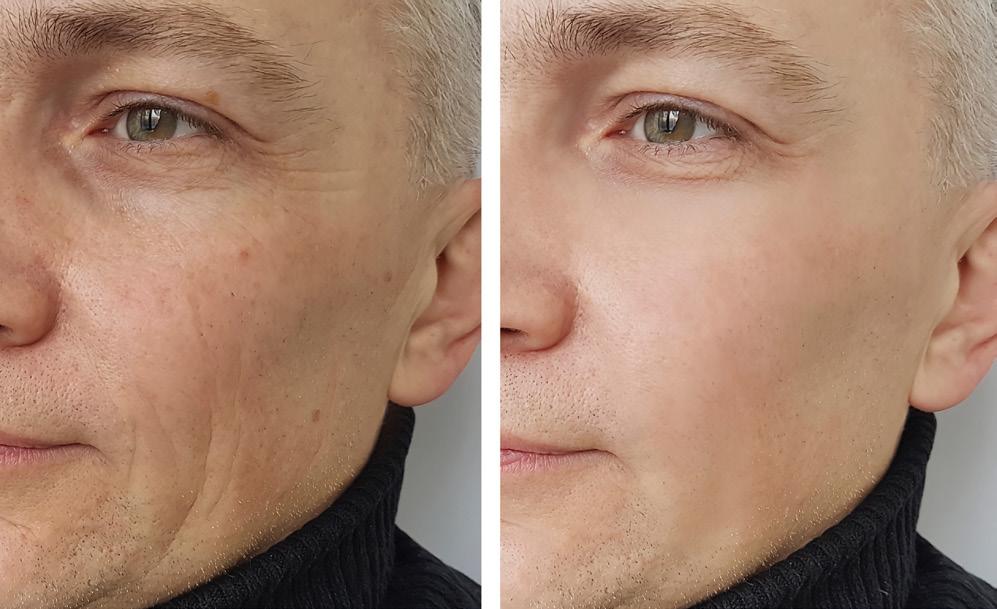



Demand for cosmetic procedures has increased dramatically since the pandemic, according to the 2022 Trends Report, issued recently by The National Association of Plastic Surgeons.
The group sent a survey to 1850 member surgeons. More than threefourths of respondents (76%) report seeing increased demand compared to prepandemic levels. Nearly a quarter of aesthetic-focused practices (23%) report their business has doubled, and 6% report a dramatic increase of more than double their volume in the past year.
Heather Lee is a double board-
certified facial plastic surgeon with the Quatela Center for Plastic Surgery in Rochester.
According to Lee, facelifting procedures continue to be popular, as well as rhinoplasty. There has been a big uptick in patients looking to optimize their neck and jawline surgically and contour the lower face with buccal fat extraction.

“Hairline lowering has been extremely popular, especially with younger patients. Lower eyelid surgery continues to be requested by patients of all ages. Locally, demand continues to be up,” Lee said.
According to Lee, the goal of
plastic surgery is not to make you look like someone else, but to enhance everyone’s natural beauty and features.
“I strive to create natural, beautiful results for each patient. Exceptional care begins with a commitment to excellence. What motivates me is the pursuit of excellence, and the focus of this intention is always centered around the patient. With this at the core of our practice, we can deliver a world-class experience with the highest standard of individualized care and results,” Lee said.
In talking with patients who see her for an initial consultation, she assesses if surgery is right for
the person and if they are a suitable candidate.
“All surgeons want to be assured that the patient’s expectations are realistic. A cosmetic procedure can boost self-confidence, but it does not change every aspect of one’s life,” Lee explained.
Vito Quatela, founder of the Quatela Center for Plastic Surgery, is the current president of the International Federation of Facial Plastic Surgery Societies. He works with facial plastic surgeons in various countries around the world and has the greatest respect for their skills.
Some surgical candidates do opt for surgery in another country. Lee clarifies that while there are qualified surgeons everywhere, it is important to realize that a successful surgery does not end after the operation. Having someone see you through the healing process is just as important, not only physically but sometimes also mentally and emotionally. The follow-up and after care schedule and availability is something to consider when picking your surgeon, regardless of geography.
Rhinoplasty, surgery that changes the shape of the nose, is a popular procedure. For many people it is cosmetic. For many others it is done to correct a breathing problem.
Rachel, a local resident who preferred to omit her last name, wanted the procedure for a long time.
“I noticed my insecurities surrounding my nose more so as I was in college and started really disliking my side profile and overall appearance. I felt like my nose grew! So, I figured I’m young enough, let’s do something about it,” Rachel said.
When she began to seriously consider rhinoplasty, she prepared herself by asking many questions.
“Dr. Lee and the staff at the Quatela Center were more than happy to answer my questions. I looked up previous work from the Quatela Center and researched what results would look like. I also saved for about a year, to financially be in a place to afford the surgery,” she said.

According to Rachel, her healing process was smooth. To her surprise, she had more swelling than bruising.
“I barely bruised at all,” she said. “After my two-week appointment, it felt like results happened overnight and the swelling came down and true
healing began. I had the procedure in mid-April and was in a wedding in June. I felt confident as ever.”
How does she feel now? “Amazing. It was the best decision of my life. My only regret is not doing it sooner,” she said. “I am so happy with how I look and the new confidence I have gained, not just cosmetically but truly within.”
Another popular procedure is blepharoplasty, a surgery that removes excess skin from the eyelids and addresses undereye bags. As we age, the skin of our eyelids droops, sometimes to the point of blocking our vision. But other people have this condition at an early age.
Kayla, another patient at Quatela Center que asked her last name not be used, is a person whose eyelids seemed to sag early in life and she had deep undereye bags.
“My entire life I wanted something done about my undereye bags, but I honestly didn’t know my options until I talked to Dr. Lee. I Googled and looked at options online before going to the Quatela Center, but I did not know what the best fit for me was,” she said. “I also was not sure how I would afford surgery or even if I was a candidate for the procedure.” She said she went in for her consult with an open mind.
“I asked what she [Lee] thought was the best option for me and explained what I was looking for in terms of results. It was
important that she could see what I saw,” Kayla said.
“The healing process is a little long. I am typically a person that bruises easily, so I would say it took about a month for my bruising to completely go away. It was around two weeks for me to be able to cover them with makeup,” she added. “Honestly, the worst part about the healing process
is the little undereye bag stretches that you must do, because your under eyes get tight and taunt. You have to rub and stretch them to get them back to feeling normal. It just feels very strange and uncomfortable.”
She said that the downtime was not bad and she took about a week off from work before returning. The results?
1 — Feel refreshed / look younger after aging from pandemic stress
2 — Noticed body changes that they want to improve now that there is more in-person interaction
3 — Put off surgery during the pandemic and are now ready
4 — Improve self-esteem / confidence
5 — Noticed things they want to improve during video calls
“I feel amazing. Mentally it has taken a load off my mind. It has made me feel more secure and beautiful. People say I look more rested. I don’t think twice about going out without makeup on or smiling in pictures. I used to hide behind my glasses, only pose in the sunshine and turn certain ways to try to hide my bags. I no longer need to do that, and it’s a wonderful feeling,” she said.

Source: The National Association of Plastic Surgeons.
Source: The National Association of Plastic Surgeons. Kayla, another patient at Quatela Center, had a blepharoplasty, which is a surgery that removes excess skin from the eyelids and addresses undereye bags.

Jian Shakakeeny is a slight woman. Polite to a fault. Bright eyes and quick answers. Proud, easy smile. The crown on her head and the “Ms. Senior Universe” sash on her beautiful dress shout that she is someone special with a story to tell and a mission to accomplish.
Her husband, George Shakakeeny, is a tenured bassoon professor at the Eastman School of Music. They met when he was teaching bassoon at Oberlin Conservatory in Ohio.
Did he woo her with his doublereed bassoon?
“No, it was the other way around,” she said without missing a beat. “I’m a go-getter.”
In truth, Jian Shakakeeny, 61, is not a go-getter; she is an irresistible force of nature.


Her first college degree from the China Academy of Science and Technology?
English. Her first real job?
Teaching English in China. She came to the United States to study philosophy and women’s studies at Southern Illinois University.
In her pocket when she got off the plane?
$30.
“I grew up in a very financially difficult situation,” she said. “Making ends meet was always a struggle for my parents. I left China with my parents in debt because they purchased the airplane ticket for me to come to this country and go to school here.”

And now, among many other initiatives that pour out of her, she teaches women about a disciplined approach to saving money and investing, about cooking to save their lives.

She loves languages. She is fluent in Spanish. She learned French and Japanese at Oberlin.
The Shakakeeny son, Nicholas, got enrolled in the “Jian Academy” when he was a babe. He started piano lessons before he could spell “Beethoven.” His mom took piano, too, “to be able to
coach him.”
Nicholas went to public school and came home to hours of piano practice, extra help with academics and baths of languages and music. She taught him to read and write in Chinese, a lot of math and financial management. He’s now a percussionist with the Fort Worth Symphony.
“I wasn’t a ‘Tiger Mom,’” she said. Sure.
George met her at one of his recitals. Or rather, she found him.
“I talked to him after the recital and I held onto the program to capture his name. Later on, I called him up by contacting the college information center, they gave me the number. You could do that in those days,” she said. “He was little scared that I called him up, but he did remember me. He thought I was this crazy person, this psycho. But after a while in our phone conversation, he thought I was fascinating, I was interesting.
“I didn’t realize there was a time difference [he lived in Ohio and I was in Illinois] and I was calling him fairly late. It was 11 p.m. in Ohio. He was getting ready to go out of town
to Boston to do a concert there. But he talked to me and asked me for my phone number. From there he was just calling me every day. Within a month he invited me to Oberlin, then two more times, the fourth time — within three months, he asked me to move in with him. I did. I quit my school and my teaching assistantship.”
George is an Eastman alum and suggested Jian get her master’s degree in instructional technology at RIT. They had a long-distance, Ohio-New York love relationship for nine months. In 1993, after she got her degree, they were married in a special ceremony on the Wagner Concert Hall Stage at Oberlin.
She got a job as a consultant for a Big Six accounting firm and started work when she was pregnant in her third trimester with Nichola, waiting to come out and be a percussionist.
After Nicholas, she got back into consulting, but stopped that when travel became too much. She took Nicholas to China and spent time reviewing traditional Chinese medicine.
“I wanted to start a natural healing
clinic,” she said. “I also learned Chinese reflexology and reiki therapy. When we got back, I started a little clinic in my home and Nicholas was ready for Jian’s Academy.”
Financial planning was very important to her…remember those $30 she clutched when she got to America for the first time.
“When we got married, my husband and I were on one income for quite a while, so I just decided that I really wanted to learn how to save and invest our limited income,” she said. “It was a very important subject for my son to learn. That’s why I incorporated that into his curriculum. Talking financial management and learning languages is my passion, I also incorporated French and Latin into his curriculum. Poor kid, you know?
“I’m not the typical Tiger Mom: I’m very tender. Nicholas thanked me when he was in high school because he said this period trained him to be responsible, to be disciplined and also knowing a lot — the knowledge really gave him the confidence to do well in school. He had high school friends who dropped out of college. He went to the Manhattan School of Music. He’s now a professional musician. He told me, ‘Never in my life would I quit school.’”
When Jian’s Academy closed down, she had more time to devote to things she’d always wanted to do. At age 53 she was studying oriental dance and international gastronomy. In 2016 she started making trips to Mexico, Costa Rica, Colombia and the Dominican Republic.

She got infected with the EpsteinBarr virus on one of those trips and developed postural orthostatic tachycardia syndrome and Hashimoto syndrome, an autoimmune disorder. In her search to get out from under the two serious medical conditions, she discovered “medical medium” Anthony Williams and adopted his cooking protocols.
“I healed myself within three years,” she said. “Basically, I was following a vegan diet with no fat and no grains. Also supplements and herbs. What we eat really matters — what we put in our bodies. I want to share that experience with people. I completely changed my cooking. Everybody loved my cooking in the past — I cooked all kinds of things and I was really into
presentation. Everybody said, ‘Your food is so beautiful and tastes so delicious.’ I had to change my cooking completely.”
“Last year, I offered to help my friend in Costa Rica to cure her autoimmune disorder by staying with her for two weeks and cooking for them every day,” she continued. “I thought, why shouldn’t I do this for a lot of families in Latin America? So, I started doing that. My friend told me, ‘Your cooking is my religion now: I am a faithful disciple.’ Wow! That is so touching.”
But she wasn’t busy enough.
“A few months before I turned 60, I wanted to enter a pageant,” she said.

She had been studying dance and performing in shows and for residents of nursing homes and saw a copy of 55 Plus magazine and an article about someone she knew, Debbi Robinson, “one of my dancing sisters.”
The first effort at a pageant wasn’t satisfying, so she did what she has always done — she took a step back and reloaded. She went to the Barbizon School to get experience in modeling. She aligned with a famous photographer.
“At the end of 2021, I went back into pageantry and modeling. I found Senior Pageants Group,” she said.

A “Ms. Senior. Universe” judging seemed right in her sweet spot.
The judging was based on an interview — she knew she could ace that. And on presentation in a nice dress — she was already a model and very slim. No problem there.
She would have to make a presentation on her philosophy of life, something she’s been preparing
every day since she was a little girl. And she had to do a talent presentation — a dance. The contest organizers granted her extra time when they saw her video.
And earlier this year, she won. She is Ms. Senior Universe. She got a crown, a sash, a trophy — and a push to do more.
“I really like the group’s mission, to honor and celebrate the lives and accomplishments of women over 60 and to encourage women to accept who they are and to try and understand they can still offer a lot to the world,” she said. “For me, that’s indeed the case. I still set goals, short term. Midterm and long-term goals. My shortterm goal is to win an audition for the leading role in a dance production of ‘The Wizard of Oz.’”
She took the crown and sash to the United Nations as an at-large ambassador for all beautiful women of a certain age. And she has more plans.
“I have this platform for a personal stance,” she said. “I want to help women. In order to live a long and productive life, we really have to take control of our biological aging process and our health. How do we do that? We have to constantly upgrade ourselves in our knowledge about nutrition and our food.
“Another thing I’m really passionate about is financial independence. It’s not just for older women. For younger women, it takes time to accumulate wealth. You need discipline, and small actions, consistent small actions, to accumulate wealth. When we become financially independent, we can really pursue what we’re passionate about which will elevate our happiness and hence our overall well-being. I think that’s really so important. Happiness. The confidence.
“In my life, I feel so incredibly confident. I’m very action-oriented. For me, I have to be disciplined, but also creative and resourceful. This is all part of my philosophy of life. It doesn’t matter what you do. My approach to everything I do — I always have something creative or resourceful; I never really go by the book. I like to bend the rules to do something different.
“When I was in college, one of my college friends said, ‘Jian, you always try to be different.’ I said, ‘I’m not trying.’”
His volume, or yours? Up and down it goes. If hearing the TV has become challenging, we can help. Schedules and registration for free programs are at hearinglossrochester.org

'I always have something creative or resourceful; I never really go by the book. I like to bend the rules to do something different.'
To hear more of Frank’s story and learn if CyberKnife is right for you, visit hoacny.com


Frank chose non-surgical CyberKnife® at HOA –offering 5 treatments instead of 35!


“The original diagnosis was to treat my prostate cancer with seven weeks of radiation, five days a week. I was kind of upset that I was never given the option of CyberKnife,” said Frank. “The precise radiation achieved by CyberKnife, far fewer treatments, and the personalized care I received from Dr. Chin and his team made my decision an easy one. Better, the treatment was a real success!”

Q.: How long do I need to work to become eligible for retirement benefits? Everyone born in 1929 or later needs 40 Social Security credits to be eligible for retirement benefits. You can earn up to four credits per year, so you will need at least 10 years of work to become eligible for retirement benefits. During your working years, earnings covered by Social Security are posted to your Social Security record. You earn credits based on those earnings. If you become disabled or die before age 62, the number of credits needed to qualify for Social Security benefits depends on your age at the time you die or become disabled. A minimum of six credits is required to qualify for Social Security benefits regardless of your age. You can create a my Social Security account to check and periodically monitor how many credits you have. Just go to www.ssa.gov/myaccount.
Q.: Will my retirement benefits increase if I wait and retire after my full retirement age?







Yes. You can increase your Social Security retirement benefit in two ways:


• You can increase your retirement benefit by a certain percentage if you delay receiving retirement benefits. We will add these increases automatically from the time you reach full retirement age until you start receiving benefits or reach age 70.
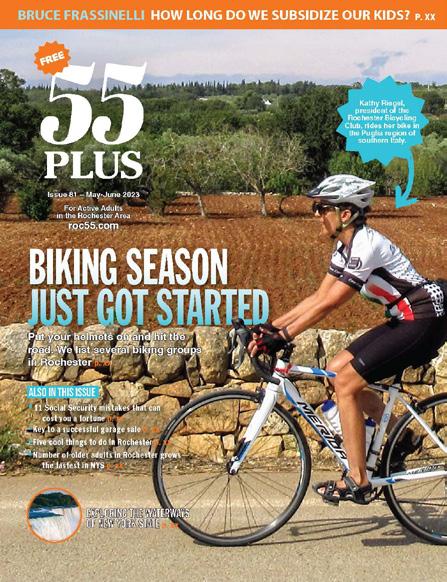
• If you work, each additional year you work adds another year of earnings to your Social Security record. Higher lifetime earnings may result in higher benefits when you do retire. For more information, visit www. ssa.gov/pubs to read, print, or listen to our publication, When to Start Receiving Retirement Benefits. You also can use our Retirement Estimator at www.ssa.gov/estimator to determine your estimated future benefits.



One step inside the Petrucci brothers’ upholstery shop on Main Street, Fairport, and the vibe is unmistakable: maestros are at work here.
Equal parts fine art studio, mad scientist laboratory and Willy Wonka chocolate factory, the Petruccis’ sprawling workspace hums with creative energy.
There’s a lot to take in — a halfcentury’s worth of vintage sewing machines and precision measuring and cutting tools occupy every tabletop and work bench. Miles of technicolored, multi-textured fabrics and thread, webbing, stuffing and batting line racks and walls floor to ceiling. It’s a chaotic symphony of textiles, skill and passion just waiting to transform old into new, mess into masterpiece.
How could it be otherwise?
Every day for the last 55 years, Peter (Pietro) Petrucci, 85, and his brother Rino, 78, have worked side by side stitching, pleating, tufting and welting, giving new life to some of Rochester’s finest and most storied furniture pieces.
Not the least of which are now luxury accommodations for concertgoers at Rochester’s landmark (Eastman) Kodak Theater.
When it came time a few years back to restore 300 plush theater seats and upholster two stately four-panel doors, project heads turned to J & P Upholstery. The task was monumental, but one Peter and Rino were honored to take on.
All in the family
It’s been that kind of “go for it”
work ethic that’s kept the Petruccis going strong for decades.
That and their shared passion for excellence, love for their craft, commitment to family and quick wit and humor. After all these years, the two finish each other’s sentences — each in the same deep, rich Italian tones.
Ask the brothers who’s in charge, and they laugh and point to each other.
“I’m the slave, he the boss,” quipped Rino in his signature staccato cadence.
Peter opened J & P Upholstery in Rochester in 1965 with his late brotherin-law John, and in 1968 Rino joined Peter and the two have been together since.
So how do they still get along after all these years?
“Everybody ask us that question,” laughed Peter, echoing Rino’s thick accent. “‘You brother and you work together 55 years?’ They just shrug. They don’t understand.”
Rino said their family has always been close, and that makes all the difference.
“You can’t agree on everything — it’s always something,” he said. “But when you are close and love each other, it’s going to be hard to fight and not talk to your brother anymore.”
“We’re never done,” he added. “It’s your brother — it’s your sister. To me it’s a no-no [to battle]. I don’t care what they say, I don’t care who’s right or wrong. You make a mistake, you fight, but it should be over in an hour. Maybe even less.”
Do Peter and Rino ever disagree?
“Oh yes, every day,” said Rino. “We just talk to each other.”
They also learned the value of hard work at a very young age.
“When we were in Italy, since you are 7 years old you working, especially when you got a farm and animals, you be working every day,” said Rino.
It’s that kind of responsibility that keeps “the mind clean and clear,” he said.
“When we came to this country it was even worse because you have no experience for anything, no language,” said Peter. “It was really tough. But slowly we get there.”
Nowadays they don’t have to work so much, but they want to, because it “keeps the mind clear,” they said.
“You talk with the people and that makes you really happy,” said Peter. “You working and you gotta be careful what you do — your mind is always sharp. It’s not easy, but you have to do what you have to do.”
Another good reason for getting out of the house, Rino joked, is so they
don’t have to spend too much time with their wives.
“They tell you what to do otherwise,” he laughed, adding, “I’m kidding.”
The Petrucci brothers have been creating masterpieces out of their 120 N. Main St. building in Fairport for 43 years now. They know every inch of it “like a woman knows her kitchen,” said Peter.
And like the brothers, the historic structure itself has stories to tell.
In 1935, it was home to a Chevy dealership, with a phone number that was simply “81.” It was also a gas station. In 1958, the building, then a restaurant with apartments on the second floor, was heavily damaged in a fire.
Today a vintage Westinghouse refrigerator, old enough to have greatgrandchildren of its own, still purrs
like a kitten and does its job beautifully in the upholstery workroom.
Forty-year-old sewing machines still create masterpieces because “if you maintain them, they last,” said Peter.

How fitting.
After 55 years, the brothers show no signs of slowing down — not when business is booming with longtime customers and their adult children who’ve now also become customers.
“It’s all word of mouth,” said Rino. “That’s why we haven’t advertised for the last 20 or 25 years — business is crazy.”
As they’ve proven again and again, Peter and Rino are not afraid to tackle a complicated job, even one that’s been rejected by other professionals in the area.
“If it was upholstered at the factory, we can do it again,” said Rino, recalling a particularly tricky German sofa that folded into itself.
 This 40-year-old Consew 228 is still Peter's and Rino's go-to sewing machine. Photo by Melody Burri.
This 40-year-old Consew 228 is still Peter's and Rino's go-to sewing machine. Photo by Melody Burri.
“We took it apart piece by piece and put it back together,” he said. “When we delivered they were so, so happy and we were happy.”
Peter was quite young when he first discovered the career that would give him so much joy and satisfaction through the years. He was working with formica in a Canadian factory. When some of the workers went on strike, his supervisor reassigned him to their floor where he laid eyes on the upholstering textiles and machines.
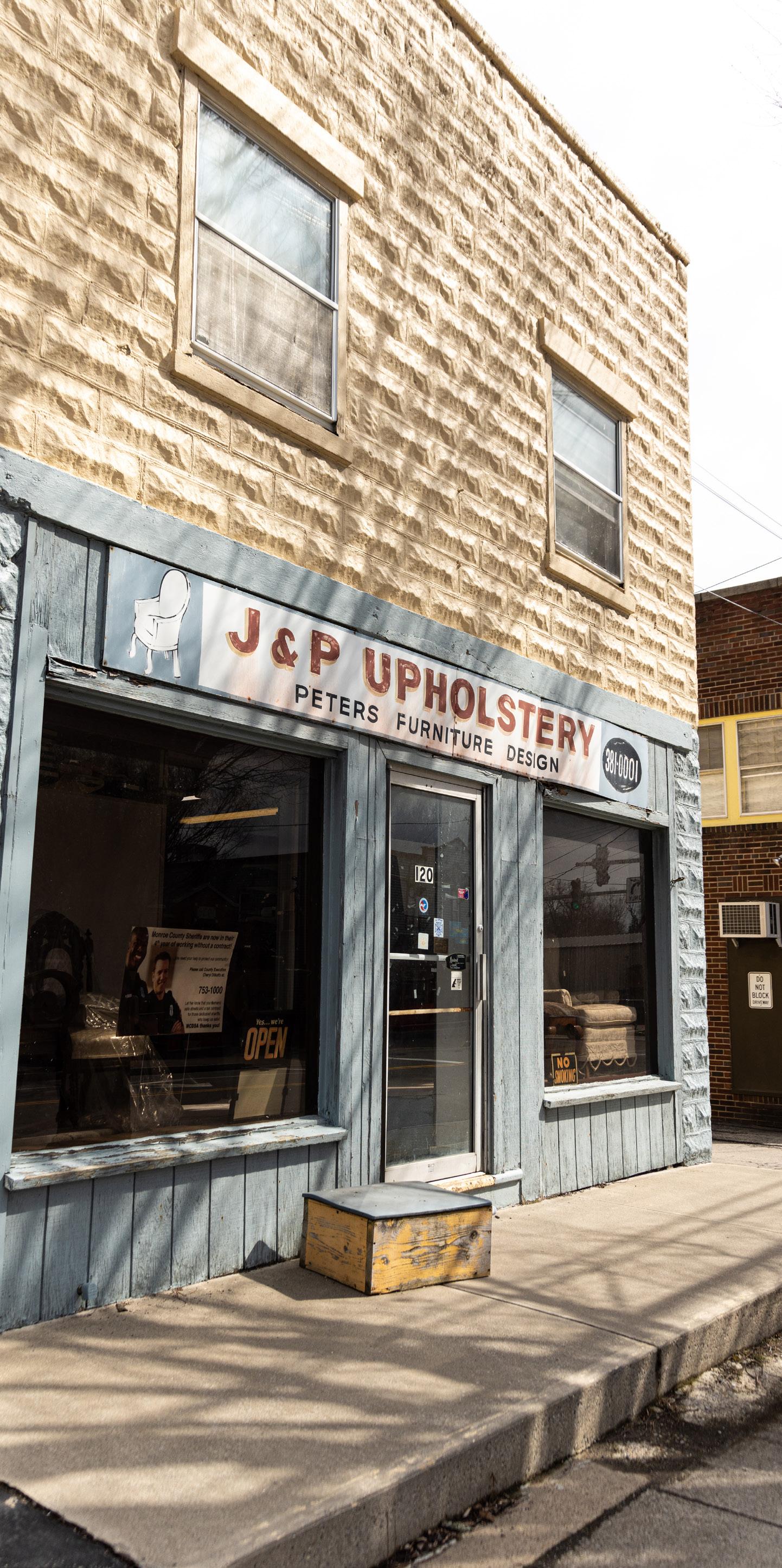
“When I saw this, I fall in love,” said Peter.
He worked as an upholsterer for three weeks until the striking workers came back. The supervisor had taken note of Peter’s natural ability and craftsmanship, liked it, and opted to keep him upstairs. It was a lifechanging decision.
After that, when his boss would move to another job at another factory, he’d take Peter with him.
Now Peter has a wife, two daughters, a son and three grandchildren. Rino has a wife, three daughters and four grandchildren.
“Don’t take her out of the kitchen,” joked Rino of his bride. “If you take her out, you’re done.”
Like many small business owners their age, Peter and Rino say their children and grandchildren have no interest in taking over the business.
“They’ve got a better [idea],” said Rino. “It’s hard work and especially today, you don’t make anything.”
“They’ve got their own life,” agreed Peter.
Instead, he gives this advice to his grandchildren: “If you do something, you gotta do what you like to do — you’re gonna be good,” he said. “If you do something you think you gotta do because you have to make a living, don’t do it, because you’re never gonna be happy.”
As he looks back, Peter said he has no regrets.
“My wife and my brother and my sister — they were college person,” he said. “I’m no college person. I like to work with my hands.
“You go through life with a lot of things. It all depends how you take it. People are respectful to you if you are respectful to them. If you keep busy — your mind goes a good way.”
You are invited to join the new Director of the Ontario County Office for the Aging, Triciajean Jones, as we visit communities throughout our County, to review the recently completed NYS Community Assessment of Older Adults Survey. Discussion topics may include health and wellness, community opportunities, caregiver themes, and aging in place - all with the primary goal of hearing from you and the services needed to maintain good health, independence and wellbeing. Please visit www.ontariocountyny.gov for further details.
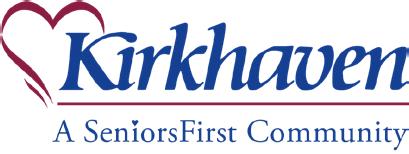






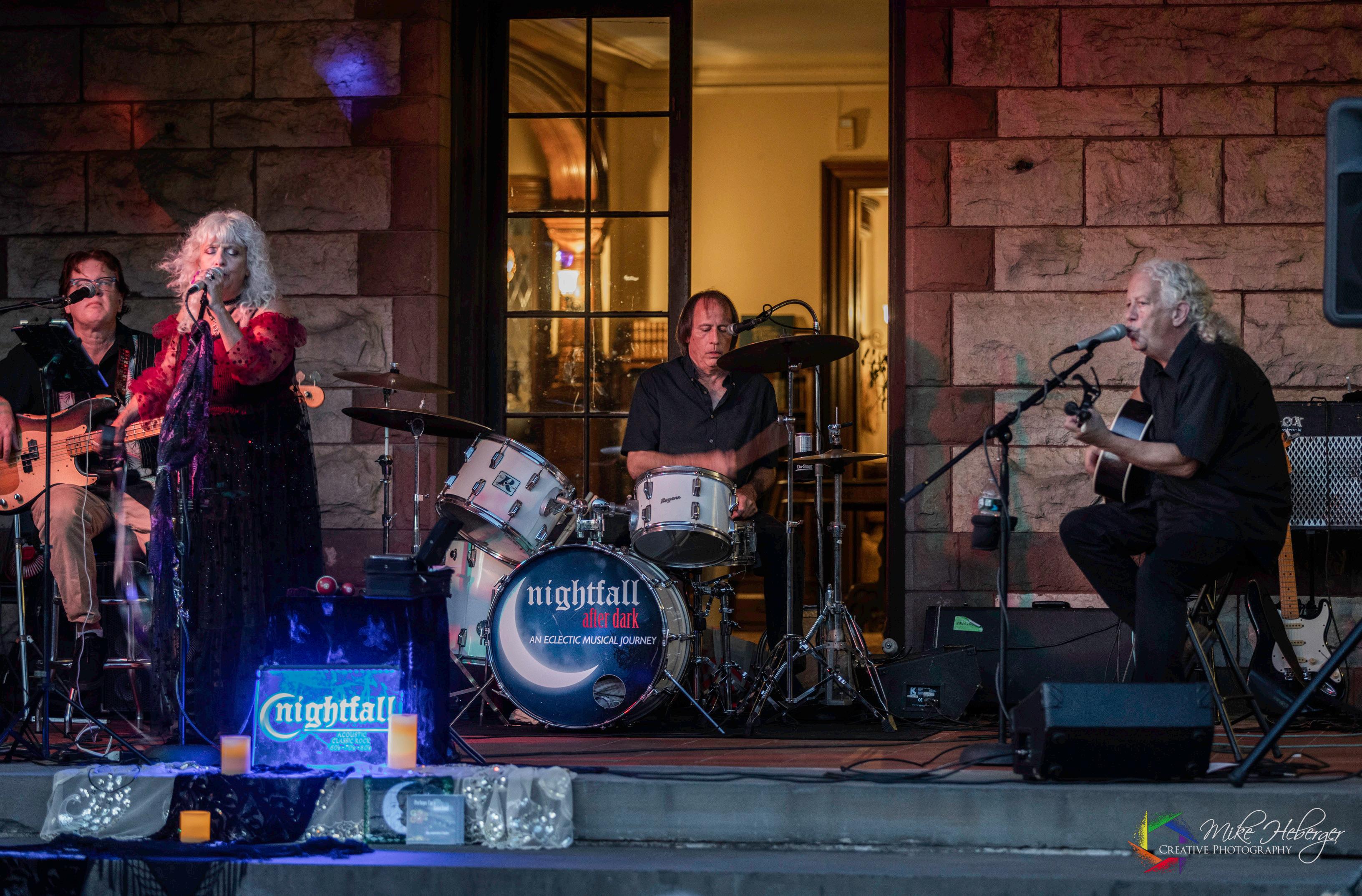 By Lynette M. Loomis
By Lynette M. Loomis
It all began in 1994, when Lisa Commentucci was out with a girlfriend at The Spur of the Moment, now Russell Station Bar and Grill in Rochester.
They saw Steve Lowden and Walt O’Brien in their band, The Avengers. She was enchanted by their music, so much, she and Lowden fell in love and just celebrated 28 years of marriage.
“Steve and I love sharing our passion for music and playing for people. It enables us to be creative as a couple and music strengthens our bond!” she said.
For 20 years Lisa Lowden enjoyed modern dance at the Cobblestone Arts Center and was always going to see Lowden in his various bands. Lowden encouraged her to pursue this career and be part of his musical life.
“In the beginning I was quite shy on stage with a mic, it is much different than just dancing! Once I came out of my shell, I blossomed with all my love and expressions from both dance and singing. My feeling is when you come see a band, you should be entertained as well as hear fantastic music,” she said.
She was 45 when she began singing.
As her day job, she owned a web design business, Wyld Woods Media.
She recently retired to invest her time in booking the three bands, doing social media marketing and maintaining their website and calendar.
Steve Lowden is an addictions counselor, O’Brien is a full-time musician and Jim Lampert is partially retired, he works as a contractor for Management Concepts. All four play music weekly.
The bands have gone through
several changes. The first band was Entwined with Lowden, Susan Janneck and her husband Bob Janneck with four-part harmonies.


The Imaginary Band, a full band, was their next collaboration.
“That was a different lineup, but just as fun! That is the band where I ‘cut my teeth’ so to speak,” Lisa Lowden said.
There are currently three bands. Nightfall After Dark, Nightfall Duo and Nightfall Trio. They play music from the ‘60s to the ‘80s that includes artists such as Simon & Garfunkel, Fleetwood Mac, Tom Petty, The Rolling Stones, Linda Ronstadt, America, The Eagles, CCR, The Beatles and so many other great artists from those music years. They also play their originals, including some fun “one-hit wonders” that they loved on the radio from that era.
She explained the reason for three groups: “It is a way to offer our venues many different ‘flavors’ of our talents. For example, if it’s a restaurant, we keep it small with the duo, and must be particular with our sound. The trio adds another dimension of songs.
“The band has a love for the classics and my husband is my acoustic guitar player in all three bands. However, what makes Nightfall After Dark unique, Steve switches his acoustic guitar mid-way and then he plays the drums for the next few sets. (Walt plays the first set on the drums, then goes on to electric guitar). It’s such a diverse way to showcase these amazing musicians. Our bass player, Jim Lampert, also plays upright bass and that adds another layer to the music selections.”
“Every one of my bandmates sings and we are ‘old school’ with our harmonies,” she added.
The “boys,” O’Brien, Lampert, and Lowden started playing together in their early 20s in a few different bands such as The Avengers, The Insiders and The Pawns. All members are older than 60 and still going strong.
She said that her most memorable performances have been at the historic Sonnenberg Mansion and Gardens.
“We play their evening stroll series, and all the gardens are lit up like little fairies everywhere! It’s an enchanting way to perform the music you love, surrounded by nature.” She said, “‘It’s All About the Love’ is my tag line for our bands.”
Lisa Lowden in her studio. She was a dancer who started singing at age 45. “In the beginning I was quite shy on stage with a mic,” she says.Vintage and antique hotspots along Route 20 in the Finger Lakes
 Story
Story
and photos by Melody Burri
Let’s just get this right out in the open: I am an antique junkie. And the hunt for all things old and beautiful is fast becoming my hands down, 24/7, go-to drug of choice.
To me, there are no sounds like creaking floors, tinkling china and muffled whispers. There are no sights like weathered wood, rusty metal and floor-to-ceiling treasures waiting to be discovered.
The dusky scent of vintage books, old cameras and hand-crafted tool boxes — count me in.
The rhythmic purr of antique pocket watches and satisfying clicks of padlock tumblers yielding to their soulmate keys — sign me up.
I realize that at this stage of my life, I’m supposed to be downsizing, simplifying, ridding my life of unnecessary “stuff.”
So why do I feel irresistibly drawn into every flea market, barn sale, roadside co-op and junk store in the state?

Why is my knee-jerk reaction
always to brake hard and veer over the second I see that multi-colored “open” flag flapping in the breeze?
It’s simple — antiquing lets me connect with my past.
When I comb through dusty piles of who-knows-what to discover the toys, technology, decor and memorabilia from my childhood, it triggers tidal waves of memories.
In those moments I’m revisiting my parents and grandparents in our childhood home, swapping stories about our day.
The grin on my face and saucersized eyes make it impossible for me to play it cool and barter like a pro, but no matter. I’d be happy to purchase some of these touchstones, but it’s not essential. The true joy is in discovering and connecting with them, and getting to know the people who sell them.
Fortunately, as a writer, photographer and rabid van camper, I get to do a lot of traveling throughout the Finger Lakes and Adirondacks. Which gives me all the excuse I need to test drive every shop, mall, yard
sale or out building with signs that bear the words “vintage,” “antique,” “flea” or “junk.”
Not all venues are equal, to be sure. Each has their niche, just as each collector has their passions. Mine are old locks and keys, vintage cameras, quilts, tools and toolboxes.
With that in mind, here are a few of my perennial favorite destinations along Routes 5 and 20 in the Finger Lakes, listed for arguably subjective reasons and in alphabetical order. Each is run by shopkeepers and store owners who clearly love what they’re doing and who do it well each and every time I return.
Melody Burri is a 67-year-old writer, photographer, lock and key collector and retired pastor. A collector for most of her life, she began focusing on touchstones from the past, particularly vintage cameras, keys and padlocks, in 2018. Learn more at melodyburri.com To recommend other antique stores, co-ops or flea markets to spotlight in future publications, email melodyburrimedia@gmail.com.
Slow down on Route 20 as you approach Flint Creek in Stanley. If you’re doing more than 40 mph you may get flagged for speeding.
And you’ll likely miss the lifesized deer statue in front of the big red barn, home of Carriage Factory Antiques.
And you’ll definitely miss chewing the fat with longtime collector and dealer Charlie Foster.
The 70-year-old’s been at the red barn for the last 23 years, but his story started long before that.
It was 1987 when Charlie’s wife decided to replace a little drop leaf table she’d refinished for their kitchen.
“We set it out in front of the house with a tag on it and it sold within a couple of hours,” said Foster. “That was the beginning.”
Some 36 years later, business is still going strong.
“Some people don’t consider a lot of the things here as antiques,” he said. “We have an eclectic mix, a menagerie of things. We buy quantities and look for things that are interesting, that make people think, that have a little history to them.”
Over the years he’s bought a lot of estates and accumulated a lot of
“stuff.” About 90% of that he has passed through Carriage Factory Antiques, he said.
A unique feature of this threestory, one-vendor operation is that similar items are all grouped together. So if a customer is looking for, say, wooden and metal boxes, they’re all in the same location instead of spread out in multiple locations.
“Customers used to come in looking for something specific,” said Foster. “Nowadays they come and discover different things they might be interested in. People will come in and spend a couple hours pondering on things, and if we display it correctly and we explain it correctly, we make a sale.”
In addition to standard antique shop fare, Foster’s got tons of hardto-find hardware, wooden and metal boxes, and furniture of all styles.
“I have an eye for what creative people will want,” he said. “I like the odd and unusual — large cauldrons, airplane nose cones, lifesized deer — I don’t buy oak dressers and stuff like that.”
In his off time, Foster curates his private collections of Popeye memorabilia, vintage keys and memorabilia from Canandaigua and Geneva and the area. His store is open
only on weekends.
“I’m retired and I love the business, but I like to be with my family more,” he said. “I have other hobbies and I’m always busy doing something.”
• Key Features
Storied merchandise, humorous finds, vintage hardware, open weekends only
Carriage Factory Antiques
2348 Routes 5 and 20, Stanley Friday, Saturday and Sunday 10 a.m. to 5 p.m. 585-526-6076
www.facebook.com/
Carriagefactoryantiques
Not wheelchair accessible
McKay’s Antiques, Caledonia
An eclectic mix of everything from true antiques and collectibles to vintage and early primitives, McKay’s on Main Street in Caledonia is both a decorator’s and collector’s paradise.


From its angled parking and spacious raised boardwalk to its enticing signage and window displays, McKay’s is a charmer inside and out.
The circa 1890s building saw
significant restoration efforts in 2010 when it was purchased by Army veteran Rick McKay, who upgraded the basement and upper floor for retail use. Today, about 25 seasoned vendors maintain three jam-packed floors of well-staged, multi-layered and richly textured displays.
“I try to keep quality stuff in here,” said McKay, now 70. “I also look for funny stuff, eclectic stuff with lots of range.”
Like many shop owners, he enjoys kibitzing with customers.
“I love the people,” said McKay. “I get a smile and it makes me happy.”
The shop’s walls are lined with framed art of all styles, select furniture, kitchenware, collectables, all things wood. Vendor Jeremy Rittenhouse, who also works part time behind the counter, said the store has “everything from looney tunes glasses to Soviet propaganda.”
“I’ve always liked old things,” he said. “I like interacting with customers. Almost everybody who comes in here is pleasant and interesting. And you’re constantly learning about things.”
When he’s not at the cash register, Rittenhouse can be found roaming the store, feeding his own collecting habit.
“I not only work here, I’m their best customer,” he quipped.
Plan some time to browse all three floors at McKay’s, because you’ll need it. And don’t be shy about making an offer if you feel it’s warranted. If the vendor is not in the building, Rittenhouse will make a call or two to float your number by the seller. That way everyone can leave smiling.
Key Features
Helpful staff, flexible prices, lighting, art, decor, multiple vendors, right around the corner from Reflections from the Past Antiques
McKay's Antiques
3113 Main St, Caledonia
Wednesday through Sunday
10 a.m. to 5 p.m.
585-538-2350, mckaysantiques@ gmail.com
www.mckays-antiques.com
Not wheelchair accessible
Dan McAndrew is building an empire on value, variety and relationships. His sprawling 7,000-square-foot. strip mall storefront has quickly become a one-of-a-kind vintage and

variety five and dime that boasts customers wearing everything from Louis Vuitton to Levi Strauss.
“I want to be known for having quality merchandise at an affordable price,” said McAndrew. “This is a place where you can find anything and you never know what you’re going to find.”
Piggy-backing on the success and longevity of the town’s über popular East Avon Flea Market, McAndrew launched Over the Moon last summer in Avon’s Main Street in what he describes as “an active plaza with unlimited parking, so I get plenty of traffic from other businesses.”
He sources merchandise from whole house buyouts and cleanouts, but McAndrew says he’s very particular in terms of the houses he selects.
“There has to be quality,” he said. “If stuff’s in terrible condition or if it’s all new and not resellable, I just pass on those houses and look for better opportunities.”
Like Carriage Factory Outlet, Over the Moon is a one-vendor operation. Which means merchandise is organized in easy-to-find categories, like vintage cookware, glassware, furniture pieces and sets, books, lighting, tools, technology, textiles,
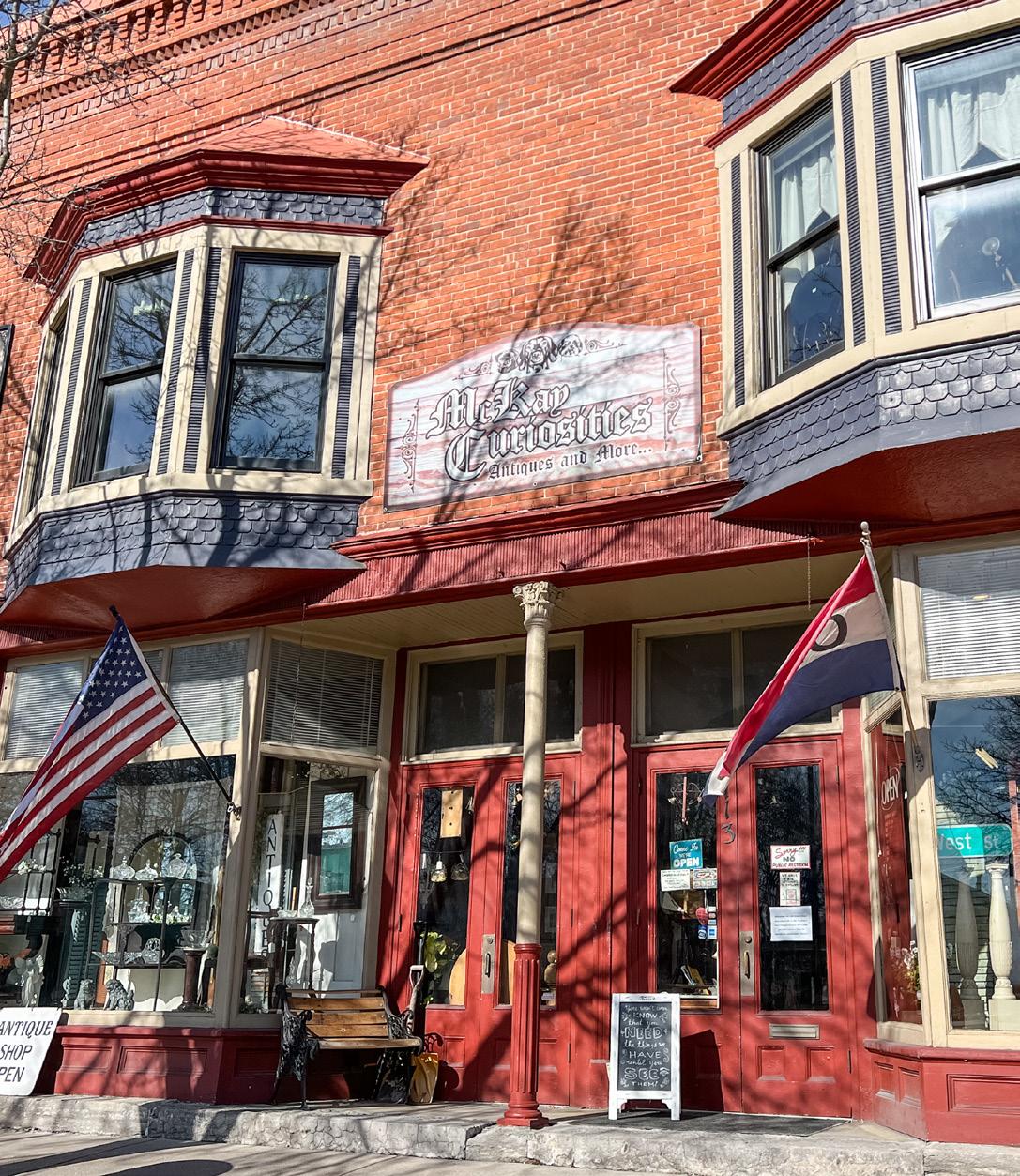 Facade of McKay’s Antiques in Caledonia.
Facade of McKay’s Antiques in Caledonia.
rugs, Christmas decor, framed art and collectibles.
And it moves FAST.
“That’s because I sell things below retail,” said McAndrew. “The only way to create turnover and keep it from piling to the ceiling is to keep it reasonable in price. People come here and furnish whole apartments, and I bundle things together and give a better price so I can move things along. I try to create a positive experience so they come back.”
And they do. It’s not just collectors and casual shoppers who are buying, it’s resellers as well.
“I like to leave room for other people to make money,” said McAndrew. “There’s a lot of people who sell online or have shops or booths and they have to go somewhere to find the stuff. My dragnet is big — I buy whole houses and get a lot of stuff at once.”
It’s obvious this entrepreneur loves what he’s doing. McAndrew said he’s been going to garage sales since he was 2 years old and his passion for vintage and antique things has steadily grown since then.
“I have eclectic personal collections beyond belief,” he said. “It’s the thrill of the hunt that keeps me going. It’s fun to dig through boxes, it’s fun to go in the old barns, in the basements and the attics. You never know what you’re going to find.”
• Key Features Variety, consistency, affordability, accessibility, fast turnover, bundling, East Avon Flea Market is nearby
Over the Moon Variety Shop
275 E. Main St., Avon Friday to Monday 10 a.m. to 3 p.m. 585-313-5606 www.facebook.com/profile. php?id=100086377505412 Wheelchair accessible
There’s no point in pretending. I know I’ll never be able to “make a quick stop” at One Potato Two in Bloomfield. So I plan plenty of
time to amble through 7,200 square feet and examine every inch of the densely populated displays artfully merchandised by some 50 vendors.
Yes, I have my favorites. But honestly, there’s not a sleeper in the bunch.
I can’t help but make time to chat with owner Carolyn Redmond and her friendly, helpful staff — many of them also vendors who can pinpoint specific items, on request, throughout the store.
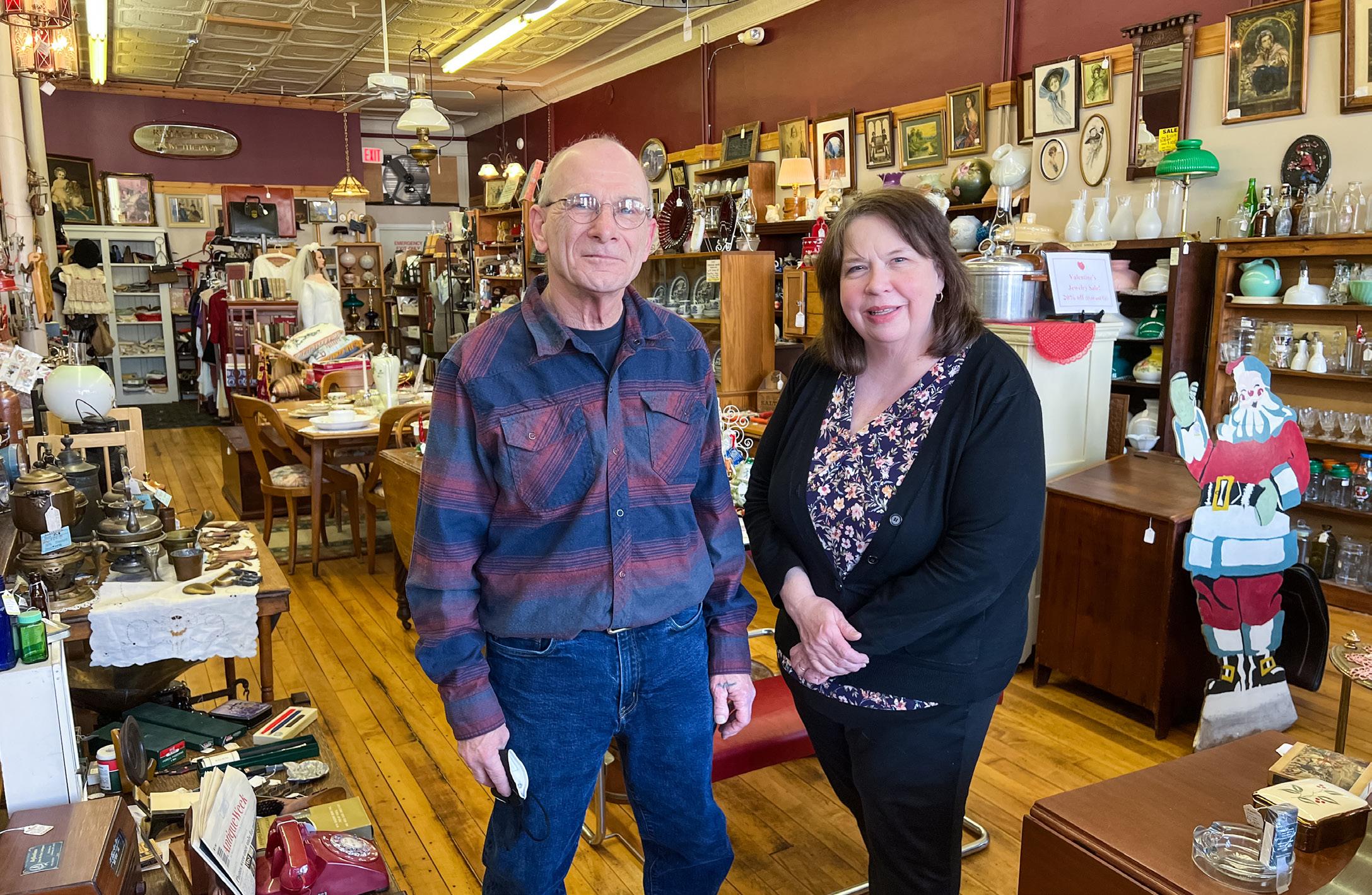
Redmond bought the store, formerly Jan’s Early Attic, almost 20 years ago in 2004. She’s seen the circle of life unfold before her eyes as infants, once brought in by their shopping parents, are returning to browse on their own.
“Now they’re sending thank you cards because of something they purchased as young adults,” said Redmond. “It’s really great.”
The store’s layout is full of interesting nooks and crannies and seems to go on for miles. Multiple entrances allow for wheelchair access and easy load-in and pick up for larger items.
“It’s a mixture of old, new,

repurposed, true antiques — everything from penny candies all the way up to oriental rugs,” said Redmond.
“I have very few people who leave empty-handed,” she said. “It’s like a mini department store. The atmosphere is pretty fun — we keep it light like that. And the people who work here are always able to help.”
In much the same way One Potato Two leans into staff-customer relationships, it also keeps things fresh with evolving decor.
“We’re constantly redoing things,” said Redmond. “I don’t sleep at night trying to figure out what the next room’s going to look like. I’ve knocked down walls and made things customer friendly by opening up the restroom for people. I love redoing stuff, and a lot of my dealers are the same.”
The store focuses on mainstream vintage pieces and antiques, but it carries its share of oddities. The strangest things they’ve sold so far have been a huge ram head and a huge fortune teller scale, along with “all sorts of huge, heavy things that take three or four men to move,” said Redmond. Items they sell regularly include
unique lighting pieces, architectural elements, small furniture, jewelry and coins.
And unlike many antique and vintage shops, One Potato Two has seen a recent upsurge in younger clients and increased sales. That’s thanks, in part, to Redmond’s daughter who’s invigorated the store’s social media presence.

Although the store’s meat and potatoes come from longterm repeat customers, they still get new people stopping in after 19 years.
“I think it’s because we offer newness and have a creative side,” said Redmond.
• Key Features
50 dealers, friendly and knowledgeable staff, variety, accessibility, creativity, repeat customers
One Potato Two 6900 Route 5, Bloomfield
Open every day 9 a.m. to 6 p.m. 585-657-7446
www.onepotatotwo.com
Wheelchair accessible
When Barb VanKeuren and Frank Burdick use the word “antiques,” they mean it.
The longtime friends and coowners of Reflections from the Past Antiques in Caledonia have painstakingly curated a well-rounded, well organized and beautifully staged showroom full of exceptional pieces.
“People say they like our shop because it’s a true antique shop,” said VanKeuren. “There aren’t a lot of newer things. We have a lot of furniture, lighting, housewares, fine jewelry, ephemera, postcards, oil paintings, lithograph prints, mirrors, books and collectibles like locks, knives, toys, railroad and glassware.”
Their inventory of showstopping vintage lamps and lampshades include oil, electric, electrified oil and aladdin lamps.
Burdick beams when he describes them.
“We don’t have vendors — we select what we purchase,” said VanKeuren. “We try to have furniture ready to go into your home. So we’re not a place where you buy something that has to be fixed up.”
Burdick said he’s been selling for 20 years in co-ops at Simco in Canandaigua, Shops on West Ridge in Greece, and even McKays around the corner in Caledonia. VanKeuren’s been at it for about 15 years.
“I’ve always liked people and antiques and love when somebody’s looking for something and I can find it for them,” said VanKeuren. “It’s not a huge money maker, but it’s a lot of fun.”
The partners say they enjoy the selection process, and admit they have to be quite picky.
“We love finding beautiful things to sell to people,” said VanKeuren. “Some people don’t like going to auctions or household sales. I don’t mind doing that, and if I can find something at a good price and sell it, I enjoy that.”
They’re a formidable pair, both with a strong knowledge of antiques, familiarity with market value and an eye for excellence.
“We surround ourselves with things we love and hope other people
love it too,” she said.
Pristine merchandise, artful displays, knowledgeable staff, right around the corner from McKay’s, wheelchair accessible
3166 State St., Caledonia, NY 14423 Thursday to Sunday 11 a.m. to 4 p.m. 585-538-9333, reflectionsfromthepastantiques@ gmail.com www.reflectionsfromthepastantiques.com
Wheelchair accessible
It’s easy to drive past the big yellow barn near the corner of Route 20 and 20A in Bloomfield as it’s tucked back off the road.
But don’t.
You’d be missing out on one of the most fun parts of grass roots treasure seeking: scavenging.
Shopkeep Tim Garlock’s bright greeting from across a cluttered barn makes you feel like you’re Norm stepping into Cheers for a cold one.
Once inside, people are often surprised at what they find, Garlock said. Hardware, bottles, some family heirlooms, tools, automotive parts — it could be anything. Even a lifesize Santa Claus.
“I’ve always been a junk collector, and my partner does barn cleanouts and whatnot,” said Garlock, emphasizing that “we’re not prim and proper here.”
No kidding. If you don’t leave with rust and dust up to your elbows, you haven’t looked hard enough.
It’s easy to be happy when you’re “surrounded by junk,” Garlock said. And he almost always is both.
His partner in crime, owner Paul Singer, grew up on the farmstead in the 1970s and later returned in 2016 with his wife, Betty, to run the roughly 1,400-square-foot business.
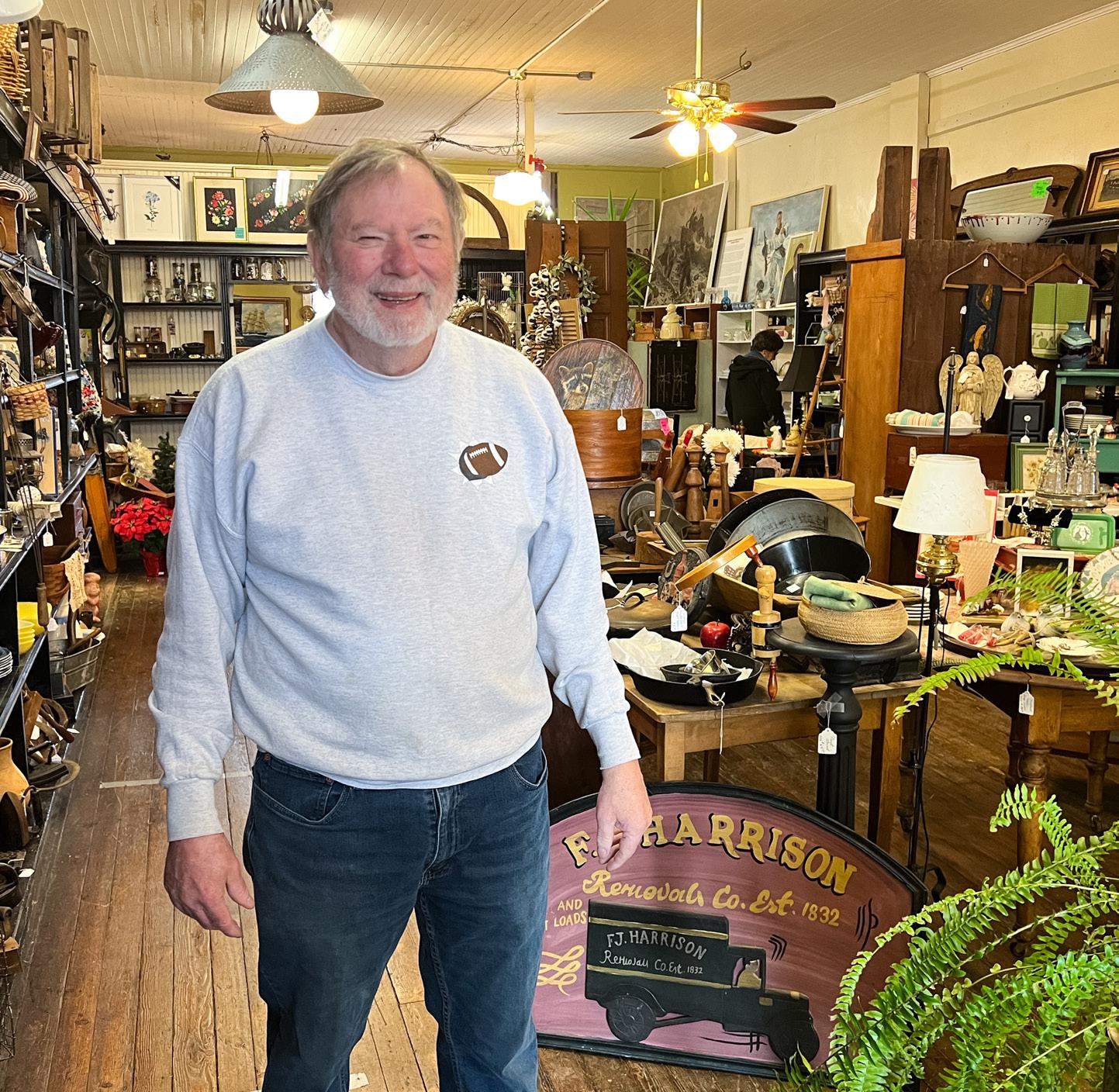
“We’re like the Sanford and Son junk shop,” he said. “We bring it in and let you guys sort it out. We gather it up, stack it up and you sort it out. You never know what you’re going to find and we have no clue what the next person wants.”
The challenge for them isn’t selling
their wares, Singer said.
“That almost takes care of itself for the most part,” he said. “The problem is finding it. If you find the proper stuff, you get good sales.
“We’ve got a lot of nice little antiques and collectibles, a lot of stuff to repurpose for people who are artists or craftspeople,” he said. “We want stuff to just go away and have a good life somewhere.”
To prove that point, when merch doesn’t sell, they pile it on a “take it home free” table.
I rarely drive by without pulling over. I love the adventure, the discovery, the “Cheers” vibe and the rust and dust that bear witness to the fun that’s been had.
Scavenger hunt, flexible pricing, barn atmosphere, great resource for creatives
6640 Buffalo Rd, Bloomfield Open every day 9 a.m. to 6 p.m. 585-430-2380
Not wheelchair accessible
Honorable Mentions
• Cat’s in the Kitchen 367 West Ave., Canandaigua
• Crossroads Antiques of Lima 7348 E Main St., Lima
• East Avon Flea Market 1520 W Henrietta Road, Avon
• Fox Farm Antiques 4127 Telephone Road, Caledonia
• Geneva Antique Co-op 475 Exchange St, Geneva
• Mantiques and Oddities Etc 3170 Wheeler Station Road, East Bloomfield
• Ontario Mall Antiques 1740 Route 332, Farmington
• Peddler’s Antiques 6980 Route 5, Bloomfield
•The Trading Post 110 W Main St, Avon
YARD SALES OFFER A THRIFTY WAY to treasure hunt in your own community for unexpected finds.

Here is a list of some of the most interesting yard sales in the region

Central New York
The Route 90 Garage Sale spans 50 miles from Montezuma to Homer the last weekend of July, rain or shine. This route is also a designated New York State Scenic Byway, so anticipate
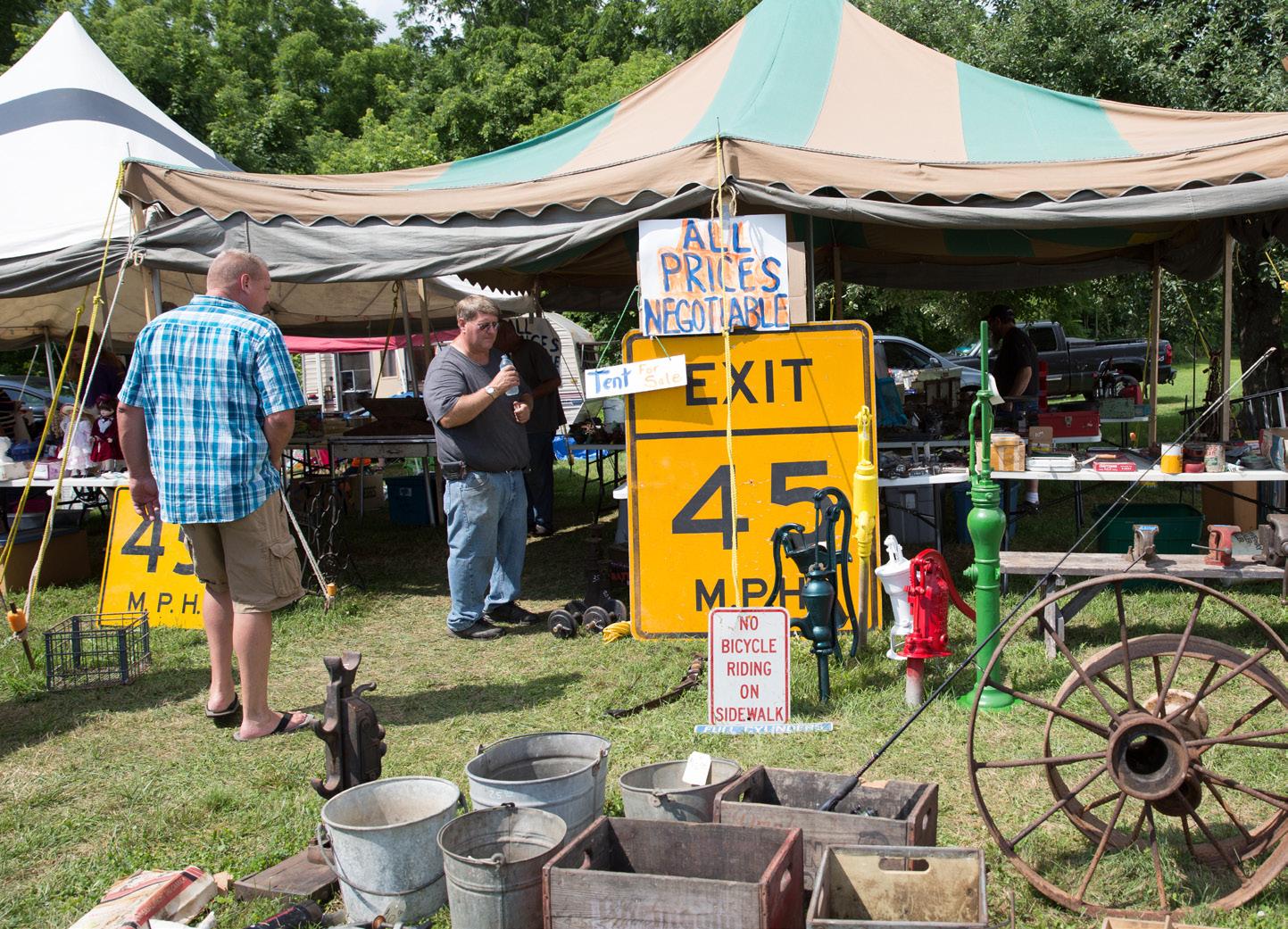
a lovely drive along Cayuga Lake. Many local organizations host food sales as fundraisers.
• www.tourcayuga.com/events
Adirondacks
The self-proclaimed “World’s Largest Garage Sale” is in Warrensburg held from 9 a.m. to 5 p.m. Sept. 29-Oct.
1. Rain or shine, the sale goes on. In addition to 100-plus individual yard sales, street vendors of food, crafts and
specialty foods and beverages offer their wares.
• https://warrensburggaragesale.com
Western New York
The Great American Garage Sales in Clarence run through fall: July 2, Aug. 6, Sept. 3 and Oct. 1. If you like antiques, these are not to miss as several antique shops are represented. The vendors arrive at dawn and leave by mid-afternoon, so arrive early enough to snap up the best deals.
• https://antiqueworldmarket.com/garage-sales
If you love music, join our community today!


















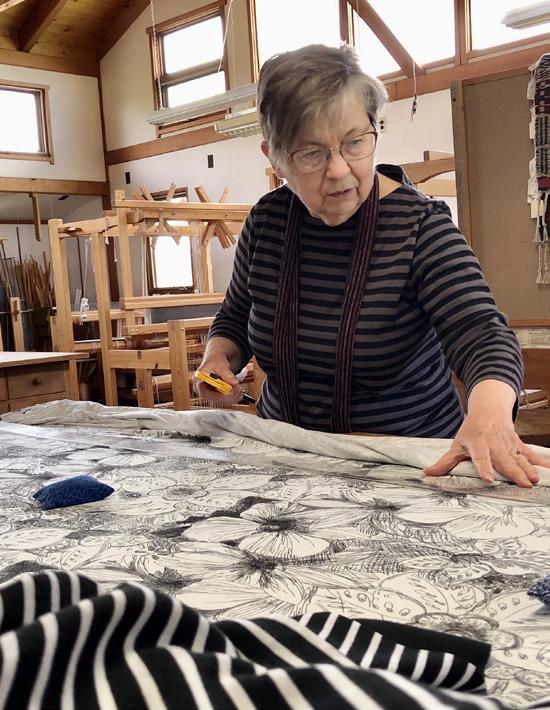



Nonprofit, already is its 25th year, has helped over 30,000 immigrants with housing and much more
By John AddymanIn the Rochester area right now are men and women and children who don’t need a description of hell. They’ve been there.
From Ukraine they come. From the Congo. From Venezuela and Haiti and Afghanistan and Somalia they come. They arrive in America with next to nothing.
“What if right now there were Russian troops coming right down this street with their tanks and guns and heavy machines?” Colleen Knauf asked. “What would you take as you escape? Who would you take to save? Would you grab your computer? What about your grandmother? What
would be the one thing you would take with you? And how would you save yourself?”
Knauf is the founder of Saint’s Place in Pittsford, a volunteer-run organization that works hard to make sure any refugee making the horrific trip from a war-torn home to Rochester has a place of their own to stay, complete with everything they need for a fresh start in a new land.
After 25 years of experience with more than 30,000 refugees, Knauf and her group have learned a lot about how grateful people can be and what doing God’s work looks like.
“One of our refugees, who now
sits on our board of directors, told me, ‘When I first came you were my first bed, my first blanket, my first bed covering. I’ll never forget the feeling when I arrived,’” she said.
Refugees are brought to Saint’s Place by social workers from Catholic Family Center, which is federally funded to process and settle these legal immigrants. After a new person’s first night in a bed in the apartment that’s been set up for them, the next morning is spent in the Saint’s Place clothing closet at St. John of Rochester parish center — more than 6,000 square feet of space dedicated to supporting newcomers to America.
Why there first?
“They don’t have any underwear,” explained Knauf matter-of-factly.
On an April morning, a young man from Afghanistan was being processed for clothing by two volunteers who helped him work his way through a room full of men’s clothes where he got fitted, head to toe.
All the clothing had been carefully screened at the former St. Louis rectory at 46 S. Main St. in Pittsford. “That’s where the donations come in. We’re lifting, schlepping, boxing, deciding whether we’re going to keep something we can use or is it something we’re going to share with another agency,” Knauf said. “We recycle every item that comes in.”
Then at St. John’s, there are large rooms for women’s clothing and men’s clothing and children’s clothing. There is a room for lamps and appliances and dishware and personal care items. Once Saint’s Place knows a family will be coming, detailed checklists guide volunteers into assembling a truckload of items that will be there and ready for the new residents to use when they get to their apartment.
Colleen Knauf started Saint’s Place in 1998, when she was working, alone, on helping to settle a Somali mom and her nine kids.

“When I started this ministry, the people coming in were so weary. I wanted them to have a clean, comfortable place to lay their weary bodies when they arrived,” she said. “These people were coming with just the clothes on their backs and I realized we had to provide clothing, too.”
As word got out about what Knauf was doing, people started arriving at her house with furniture and donated items that overstuffed the family garage.
“At one point, both my husband and our neighbors both said, ‘Would you please get out of here with all of your junk? Get out!’ So I became a nomad. I had nowhere to store the stuff. I began pounding on doors asking people, ‘Would you please give me space for no money and people did. But once they found a renter to pay them, they would kick me out. It was a constant moving, moving, moving — with furniture. It wasn’t easy.”
So people started to give her money, which Knauf used to lease warehouse space in the old pickle factory in Pittsford. But now more refugees were being brought in by Catholic Family Center and referred to Knauf and more volunteers were stepping up. Space continued to be an issue.
“In 2001 the property at 46 S. Main St. at St. Louis Church became available,” she said. “I went to the pastor, Jim Schwartz. I said to him, ‘This is a big house [it was originally the rectory for the priests when we had a lot of priests] on church property and we should be doing God’s work in this house, so I want the house.’ And he said, ‘You’re right, Colleen — you’re so
right. Go take the house.’ So I moved into the house all by myself.”
That house, something between 3,000 and 4,000 square feet, became the staging center and hosted the first clothing closet, which grew increasingly overcrowded.
“It became a problem because we have a lot of handicapped refugees who come here and they couldn’t get up those stairs. Plus, we outgrew the space. There was a small women’s clothing room, a small men’s room, a small kids’ room. We were bursting at the seams,” she said. “I knew the
school at St. John of Rochester was vacant, but I also knew it was a very sensitive subject because parents were not happy that the school had been closed. I went to that pastor. ‘Look, you’ve got all this space,’ I told Father Peter Clifford. ‘I’ve got all these refugees who need clothing. Would you be willing to share it with us — this would be a social outreach for your parish. Your parishioners can get involved. You can say, ‘We own this: it’s on our property. We’re doing God’s work here.’ He got the approval of parish council and we were in. In
from St. John Rochester. It’s a blessing for them, a blessing for us, and a blessing for the refugees.”
And some refugees need more blessings than others.
“I look back to the years when the Afghanis were coming in. The Taliban had slaughtered all the men in families, all the oldest sons and they did it in front of the mothers and the other kids in the family. Then they gang-raped the mothers and the children,” Knauf said, speaking as someone who has heard the tales too many times. “These mothers don’t get well. They can’t get well. But their kids are here now and they’re in the schools. I think about one particular family and their mother — her kids are all in college now. They knew they had to go to college. Their mom doesn’t understand this. The kids take care of their mother.”
War in Ukraine has sent millions fleeing the country and Rochester is a settlement point because the Ukrainian community here has been so welcoming, sponsoring refugees and helping to get them settled in. Things move along quicker in resettlement when someone in the family speaks English, Knauf explained.
Getting refugee kids into schools
quickly is also a vital goal, with trips to health departments or doctors first, then signing up for classes. Knauf said that Webster schools, in particular, have worked special programs to welcome the influx of Ukrainian kids.







Saint’s Place goes beyond furnishing apartments. Two tutoring groups are sponsored and staffed with volunteers. The group has sent refugees to trade schools and Monroe Community College to help them land jobs. Saint’s Place has supplied work clothing and tools for apprentices. Knauf points to another support, a separate program of awarding washers and dryers to families with a lot of kids.
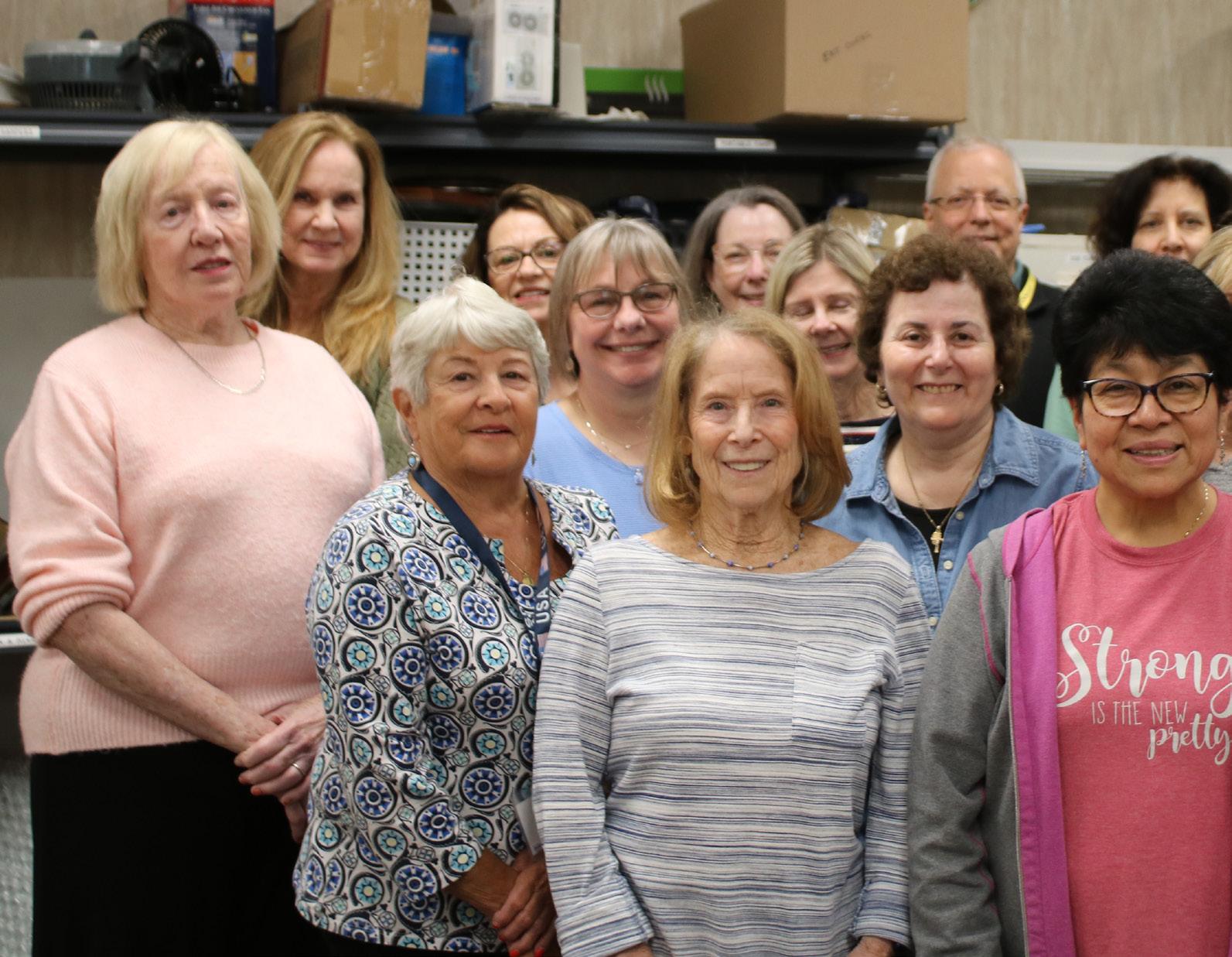
It’s clear that Saint’s Place finds what refugees need to succeed in America and works to provide it.
And now, 25 years into the ministry, Knauf is circuit-riding churches in the area to help support what will be a very busy year.
“I’m raising awareness that the Ukrainians are coming and everyone wants to help the Ukrainians, but they’re not the only ones coming into this area. Because we’re getting such a large influx of Ukrainians, I want to offer them all the things I offer all the other refugees — job training, the washer and dryer, I want to send them to school, I want to be able to help them just as much, but I can’t do it
unless the churches in Rochester help us financially,” she said. “I just sent out a million letters and I’m visiting churches physically to speak to the congregations to let people know, ’Do you know there are Ukrainians arriving? If you do know, you can help us – this is how you can help us.’

“So far, I’ve raised $50,000 since the end of December because people are empathetic and people want to help and this is the way they can do it. And I’m going to turn around and buy that laptop for somebody, those steel-toed shoes for somebody; I’m going to buy what they need with that money. People see what I’m doing in this ministry: I’m walking the walk. I remember an Afghani man. I came up to his house. He has a wife and eight or nine kids. I’m the truck driver. Bib overalls on, with a truck full of furniture. He opens his door and looks at me. ‘Why would you help me? You’re Christian.’ he asked. ‘And you’re a woman. Why would you help me?’

“As it turns out, we became best friends — he and I and his whole family. His eyes were opened up. Where he comes from — and many come like this — they come into our welcoming process and they see all these people wanting to help them. They can’t believe it. ‘Why would you help me? Why?’ They ask. Because we can and we should. That could be you and me, but it’s them and we’re responsible for them.”

Many people experience a mid-career or post-career shift; however, few are likely as varied as the precareer shift of Fumie Thorpe, 61 and owner of Thorpe Vineyard on Lake Ontario in Wolcott.


She was a Japanese astronomer from Tokyo studying abroad meteorology at SUNY Oswego more than 35 years ago when her life shifted dramatically. She fell in love with and married Jock Thorpe and the couple
subsequently purchased a winery.
While visiting her, Fumie’s father, a real estate businessman, had noticed the property.
“He could see some value in the property,” Fumie said.
It was known as Straubing Vineyard then. Owner Bob Straubing of Newark had established it in the late 1970s and had developed it into a farm winery in 1984.
While her husband and father felt interest in the property and its
winery, Fumie did not. Over the years, however, the wine business grew on her and she learned viticulture from a variety of mentors. Though she and Jock Thorpe divorced in 2008, she has continued operating the 3.5-acre winery, which produces about 1,000 cases of wine annually from her grapes and purchased grapes.
“I live in a strange life,” she said about her abrupt change of trajectory from astronomer to winemaker and from city dweller to farm owner.
But she did not forget about her passion for stargazing. Her enrollment at SUNY Oswego as a meteorology student was a compromise as the school did not offer astronomy.
“I always told my professors I’d finish it if they had an astronomy major,” Thorpe said. “The head of physics department is an astrophysicist himself. Astronomy is still not offered.”
She finished her degree in meteorology in 1991, with a minor in astronomy. However, Thorpe never
pursued a career in either meteorology or astronomy. She has found ways to include stargazing into her winery business by offering Starry, Starry Night stargazing events, named for the Van Gogh painting of the same name. She also promotes Sights & Sounds events, which emphasize birdwatching and listening, along with wine tasting.
“If you do birdwatching, it’s hard to sight them but you can hear them,” she said. “You can figure out what’s there and look into it. I started stargazing in my teens. I grew up in a big city of Tokyo, but I learned most of the constellations while in the city. You can do it and listen to the birds. I want people to get more curious looking around as to what’s in nature.”
Her location near Chimney Bluffs
State Park is ideal for access to nature. Hosting events has helped her business stay afloat during the pandemic, as people felt less nervous about going out and about in a more rural venue.
Like many business owners, the pandemic also affected her ability to find employees. While the farmworkers have been steady, helpers in the tasting room or in the manufacturing aspects of the business are tougher to find. This has led to her struggling to keep up with demand.
“I think people are willing to purchase if I have more varieties to sell,” Thorpe said. “It’s not that people don’t want to spend money; they’re not finding what they want to buy. I knew some people and thought they might be good workers, but when I talk about doing more than sitting in the tasting room, they back off.”
As both a woman and an Asian, Thorpe feels unique as a farm owner compared with many other farm owners in the area. But she’s accustomed to feeling unique, as the winery was the first commercial grape operation in Wayne County, where tree fruits reign. Occasionally, she feels that people do not accept her.

However, overall, she parlays her uniqueness into making her business stand out. She also often expresses her happiness of living where she is.
“Tokyo is a fun place, but I always wanted to live in the country,” Thorpe said. “This is a pretty place to be.”
The year 2023 marks her business’ 35th anniversary, which she hopes to mark with a special wine.
In addition to stargazing and winemaking, Thorpe also enjoys watercolor painting during the slow winter months and has painted most of the art used on her labels and in the winery’s tasting room. She also writes poetry and essays.

On May 1, found nothing in my parking space but broken glass. Thieves had stolen my beloved, carefully maintained, fully-paid-off Hyundai Sonata.

I felt as if I’d been kicked in the chest.
Mine was just one of the 1,531 cars that were stolen in Rochester between Jan. 1 and June 1, most of them Kias and Hyundais. That’s an average of over 12 a day. By comparison, only 1,135 cars were stolen in the city in all of 2022, according to a recent Democrat and Chronicle article.
A neighbor’s door camera caught the thieves that sunny morning as they quickly and efficiently stole my 2014 Sonata. Two cars pulled into the parking lot of my apartment in Rochester’s Neighborhood of the Arts (NOTA) at about 11 a.m. One parked next to my car close enough to conceal the thieves’ actions, and a second parked close by — probably a lookout. The two in the first car, which
By Mike Costanzawas another Hyundai, wore hooded sweatshirts — one black, one white. The hoods of both were cinched so tight around the thieves’ heads that only their eyes showed.
It was broad daylight, my car was parked on a raised space close to the street and and cars were passing on a nearby main road, but the pair appeared to work without fear of discovery. Black sweatshirt quickly and quietly broke my rear window. Instead of opening that door, which would have set off my Sonata’s alarm, he climbed in through the window.
After he climbed into my car, Black sweatshirt smashed the plastic casing of its steering column and started it. Due to flaws in their security systems’ software, some years and models of Hyundais and Kias are very easy for thieves to start. There’s even a video of the procedure on social media.

White sweatshirt joined Black sweatshirt, and the pair drove off, followed by the lookout. They left the other Hyundai behind with its engine
running. I later learned that it, too, had been stolen.
Police officers found my car about two hours later, after the thieves had crashed it into a tree and fled. They’d been so relaxed as they’d cruised the city that they’d stopped for fast food — I found the bag when I went to Rochester’s impound lot to look my car over. The vehicle was so badly damaged that my insurance company declared it a write-off — too damaged to be worth fixing. Though in my early 70s, I now have to spend much of each day looking for any car I can afford on my very limited income
Rochester Police Department Lt. Greg Bello says many local car thieves are juveniles.
“At times, the stolen vehicles have been used for much more serious crimes, and at other times they appear to be simply joyriding,” he says.
Bello says RPD has distributed about 1,000 steering wheel locks to Kia and Hyundai owners in response to the car thefts, and worked with other local
law enforcement agencies to identify trends and suspects.
“We have also put numerous focused deterrence details out, targeting the thieves,” he says.
The department is also working with the Monroe County District Attorney’s Office and other county law enforcement offices in order to see to it that the perpetrators of car thefts are punished.
Though cars continue to be stolen, RPD’s efforts could be having an effect.
“Although still way too high, the numbers appear to be dropping,” Bello says. “That being said, we are continuing to work on additional methods of enforcement and education, in order to reduce these numbers further.”
That’s cold comfort for Bonnie E. The NOTA resident, who asked that this magazine use only the first letter of her last name, heard a knock on her door at 1 a.m. on May 1. When she opened it, a police officer told her that her 2012 Sonata had been stolen, and was in the city’s impound lot.

When asked how she felt about suffering the theft, E struggled to find the right words.
“Violated,” she said.
She’s also angry.
“The teenagers, or whoever it was that took the car, if they are caught, the police just give them a tap on the wrist and send them home,” she says. “It just isn’t right.”
E’s insurance company has given her a check to cover her car’s damages, but she’s not sure it can be fixed. Buying another vehicle would be a struggle.

“I’m barely making ends meet right now, but I’ve got to have a car to get around,” E says.
Kia and Hyundai have found ways to fix the software flaws that make some of their vehicles easy to steal, but the owners of those vehicles have to schedule appointments with dealers in order to have the work done.
Mike Costanza is a contributing writer for 55 PLUS magazine and other publications that serve the Rochester area. He has called the Neighborhood of the Arts home since 2001.



Ihear all these concerns about artificial intelligence.
Here’s some advice: ignore it all.
What you do have to worry about is your kids — and especially your grandkids.
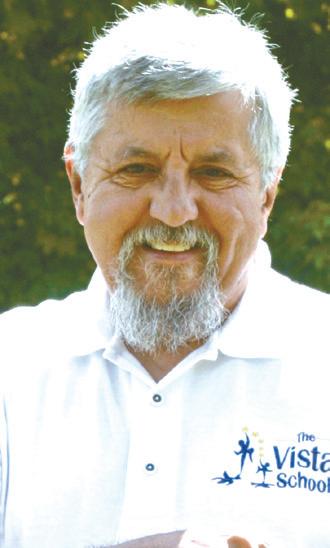
If you think you’re keeping up with the latest stuff technologically speaking — forget it. Your kids and grandkids are ahead of you — way ahead — and their lead is widening.

Artificial intelligence isn’t going to change America. Our kids will. They’re doing it now and we don’t notice.
This February, I continued a pattern I’ve developed in my life: I did something entirely stupid. I went back into teaching. Worse yet, I went back into teaching math to middle school kids, fifth through eighth grade.
Now let’s establish a fact: I am old. My youngest daughter confirms that
every time my birthday comes around.
“You’re older than dirt, dad,” she says, with conviction, like she’s informing of something new that I haven’t thought about before.
“Dirt,” she emphasizes.
I took that with a grain of salt until I got back in the classroom. Now I have been bathed in comeuppance.
My students want me to send them their homework electronically in Google docs.
“What’s a Google doc?” I ask. What happened to homework written on paper?
“You send us a Google doc and we do the homework and send it back to you and you grade it and send it back to us,” my kids explain.
“What?” I asked.
I gave them a project to do. If you teach math every day, I have discovered that sooner or later bubbles
come out the ears of students. So I gave them a project. All math and no play makes a room full of dweebs.
“Do you want us to do a presentation?” my students asked after I gave them the project assignment.
“OK,” I agree.
“Do you want us to make a video?” they ask.
“Is this a Google doc thing again?” I ask.
“We can do that,” they agree, “but we can also post it to YouTube.”
“You can?”
“Sure,” they say. “Even you can access it.”
One of my students, Jack, suggests that when I teach math every day and don’t do some different things, students will react in certain undesirable ways.
“The bubbles?” I ask.
“All over the room,” he promises. He suggests I invent some math
games. He tells me several websites that will help me do this. He explains all this to me in terms I do not understand. He says he will help me. He is 11 years old. I am, well…you know about the dirt thing.
When I was a corporate citizen and part of a software company, we had the latest technological stuff. We had people who would come to your office, sit with you at your desk, and teach you the latest changes. We were first adopters to new technology. I had a laptop before many people did. When I opened it up at a coffee shop, I was normally the only one so equipped. We all know times have changed.
In retirement, I lost all those knowledge-transfer aspects and had to do a lot of new learning on my own. But the pace of that learning has slowed down. My brain can still run at the same speed, but the opportunities are fewer.
My students have the opportunity and the will to learn so much more and do it rapidly. They talk about chat rooms they’re in. When I hear about some of the things being discussed, my guess is that parents don’t know a thing about those chat rooms. The Chromebooks they take home are powerful little computers that allow them to see a class from home, to research things on the web and have access to pieces of information in nanoseconds that used to take me several hours to find in a library.
Kids are hurtling forward in acquiring information and doing tasks and forming opinions at a speed most adults can’t fathom. There is a subculture of this informationgathering and sharing that is striking to me because its members are so young. The pandemic, which put those Chromebooks in the hands of kids, may turn out to be the trigger points for an information and technological wave that most of us won’t appreciate until it’s too late and we realize a generation of our making has left us in the dust.
For me, I have plans this summer to become immersed in Google docs and all that stuff, to once again become reasonably computer-proficient and to get ready to run with my kids in the fall when we come back to school.
But by then, they will all have learned so much more. It’s going to be a challenge for all of us. I’ll keep shrugging that dirt off me.
Grasta's helps individuals with Chemotherapy, Radiation, Psoriasis, Alopecia, Diabetes, Menopause, Childbirth, Lupus, & Burn Victims, Trichotillomania and COVID 19 related Hair Loss. Sharon Grasta provides Professional, Confidential & Personal Consultations, Fitting & Wig Care. I strongly believe privacy for my clients is #1 priority.

“Sharon was so kind & understanding and she had lots of hairpieces to choose from. She knew exactly what I needed. I loved her right away because she showed me what was good on me & the ones not good on me. Sharon was always patient with me... Sharon loves her customers and it shows in how wonderful she treats them: like family.” - Mrs Ann M. Colarertalo
High quality wigs & hair pieces in a variety of styles & blends and toppers are available.






I specialize in professional, personal, and confidential service. I enjoy making clients feel beautiful from the inside out.


409 Parma Center Rd. (Rt. 18), Hilton Just minutes from Greece Ridge Mall!
Grastasbeautyandwigstudio.com
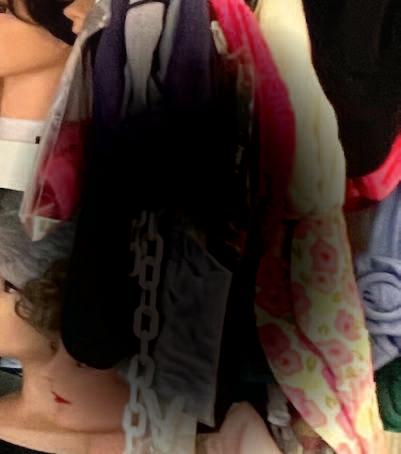
Sharon M. Grasta (Russo) – owner & operator
NO PICTURES TAKEN - ONLY FACETIME
MASKS ARE STILL REQUIRED Due to COVID-19, strict safety policies are in effect and apply to EVERYONE. We cover our styling chair in disposable vinyl. I also wear protective coverings. There is no way an operator could be three feet apart from a client while working, which is why the client and I are covered. You will receive foot coverings, vinyl gloves and a sheer vinyl cape which you will wear out to your car and discard at your convenience. Temperature will be taken at the door. No wigs are touched by bare hands. ONLY THE CLIENT IS PERMITTED INSIDE!
LARGEST INVENTORY OF TOP QUALITY WIGS IN WESTERN NEW YORK! +1 RATING



“She made me feel beautiful...”
New York has ranked among the top milk and dairy product producing states nationwide for decades. It’s little wonder we have so many places to enjoy milk, cheese and other dairy items. Get your dairy fix while enjoying a unique experience visiting these dairy venues this season.

Muranda Cheese Company in Waterloo represents one of the state’s farmstead cheesemaking operations, with the cheese cave housed in the basement of a renovated dairy barn that neighbors the herd’s barn. On the entry-level floor, peruse samples of the handmade, small-batch Muranda cheese, available in dozens of varieties and flavors so you can try before you
buy. The gift shop also features a bevy of local goods and gifts. Check social media for updates on special events.
• www.murandacheese.com

Lively Run Goat Dairy in Interlaken operates a farm and creamery not far from Cayuga Lake. After a scenic drive on Route 96, enjoy a cheese tasting, try goat yoga, feed the goats and tour the farm. The farm store sells local goods, gifts and of course goat cheese.
• https://livelyrun.com
Farther south, Engelbert Farms in Nichols operates a certified organic dairy, beef, pork veal and vegetable farm. The folksy farm store and creamery includes all of these goods, as well as other local farms’ items and shelf-stable items like
gluten-free flours.
• http://engelbertfarms.com
The fourth and fifth generations work at Sunset View Creamery in Odessa. The farm creamery recently built a new store on the farm to sell its small-batch artisan cheese. Sunset also hosts the Finger Lakes Cheese Festival the fourth Saturday in July (July 22), which offers demonstrations, tastings, food and live entertainment.
• https://sunsetviewcreamerydotcom. wordpress.com
full-service,
The farm controls the entire process from cow to carton or cone. Choose from among 70 homemade hard ice cream flavors, as well as homemade soft serve, ice cream sundaes, and milkshakes. The farm store also regular milk and chocolate milk in plastic or glass containers along with many other local goods.
• https://kingbrothers.deliverybizpro. com/our-farm-store
At Hoover’s Dairy in Sanborn, visitors can buy milk in glass bottles and shop the farm store for other local goods made in Niagara County. Hoover’s has been in business since 1920. Don’t miss the strawberry milk, a flavor not often perfected among

flavored milks.
Even older is Pittsford Farms Dairy, which was founded in 1888 and represents one of the oldest familyowned dairy business in New York still in operation. Pittsford Farms’ chocolate milk has been lauded as the state’s best. The farm store also sells more than 70 flavors of homemade ice cream by the cone or by the quart. Seasonal flavors include peppermint and pumpkin. The items served at the in-house bakery and café complement the farm’s milk.
• https://hooversdairy.com

• www.pittsfordfarmsdairy.com
Trinity Valley Dairy in East Homer has milked cows for a century and creates products like cheese curds in
several flavors and home-baked goods. It’s also one of the few dairies that sells non homogenized milk. Although pasteurized, skipping homogenization means the cream rises to the top, so customers should shake the jug before serving. The farm store sells numerous other locally made goods and the farm is open for tours by reservation.
• https://trinityvalleydairy.com
Country Cousins Farm represents one of the few raw milk dairies in the state. The small, self-serve farm store includes the farm’s own raw milk, eggs and beef, along with local honey, maple syrup, and homemade soap.
• www.countrycousinsfarm.com)
Our volunteers fill critical roles supporting older adults & caregivers.
• Help an older adult manage day-to-day finances.
• Give a lift to someone who no longer drives.
• Give a caregiver a break.

• Make a friendly phone call.
• Lead fall prevention or healthy living workshops.
• And more!
Time flexible & fulfilling! Learn more!


Reduced or non-existent pensions, insufficient Social Security benefits, skyrocketing costs and tanking investments represent just a few reasons many people continue working past retirement age these days. But if your finances are solid, it doesn’t mean you must stop working just because you have a certain number of candles on your birthday cake. Consider these reasons to keep working, whether as a paid employee, consultant or a volunteer.
in helping you stay sharp and feel useful while still allowing enough time to pursue hobbies, interests and volunteering. One example is a program in which Jones recruits those familiar with Medicaid and Medicare to counsel people about the programs.
Mary Bistrovich, director of Osher Lifelong Learning Institute at RIT, said that many retirees become involved with leading Osher programs because they feel like they lack that sense of community that their workplace had offered them. Retiring severed those relationships and curtailed their daily schedule.

“They’re not as mentally challenged as they were,” she said. “They might not be moving as much. When people come here, it’s a peer learning and teaching program.”
www.lifespanrochester.org

“The connections you make at work and being part of something is good for your wellbeing,” said Triciajean Jones, director of the Ontario County Office for the Aging.

Whether it’s continuing to work, or developing means to mentor, consult or freelance, Jones believes that the “ability to give back is good for your wellbeing on both sides. Those close to retirement haven’t stopped in 45 years. What makes them think they’re going to drop work and pick up something else? Whatever is purposeful for you, it’s good to stay active. It feels good to be needed.”
She values the experience and skills older workers have to offer and views them as a resource.
Even part-time work is helpful
Teaching a class at Osher is not a long commitment. They range from one to 10 weeks and center on a topic or interest in which the leader is wellversed. Bistrovich finds that class leaders enjoy sharing about their specialty with others because they feel like they’re still connected to it.
“It gets people out of the house and into a situation where they can make friends,” she added. “Many people say about Osher, ‘It’s the reason I get out of bed in the morning.’ Otherwise, it’s too easy to be complacent. It gives you a sense of purpose.”
Quite a few Osher members and peer class leaders work part-time or provide pro bono work in their specialty, along with volunteering locally.
“They really try to keep as active as possible. That keeps one healthy,” Bistrovich said.
By Deborah Jeanne SergeantWhen you do good, you feel good!









Q: You’ve enjoyed a number of diverse roles over your professional career. What were some of your favorites?
A: I started in high school as a reporter and photographer at the Gates-Chili News. Students were given a page in each edition of the town’s weekly newspaper for school news, so I got used to meeting a deadline every week. One of my first stories was supposed to be simple — how did the town of Chili get its name? What I found out was that the answer depended on whether you talked to a Chili Republican or a Chili Democrat. I learned quickly that even local history involves a lot of politics.
Starting in 1983, I worked for the University of Rochester where I had three assignments over the course of 32 years, all in public relations, editing and print and web production. My last 10 years at the university were as associate director of marketing and communications at the Simon School of Business.
I retired in 2012, but my friends claimed I flunked retirement because I’d been hired as the part-time clerk of the Farmington Planning Board before I even left the university. I’m still working for Farmington and recently retired as the stenographer for the town of Canandaigua Planning Board.
Q: Your lifelong passion for history appears boundless. What is it that most intrigues you?
A: When I left the university, I missed the mechanics of typography. It’s a lost art; I’m afraid, with too many desktop publishers and printing production that has evolved to digital presses.
Though newspapers are becoming a thing of the past, printing is still with us. So I started a small business — Finger Lakes Historical Press — to print other people’s local history books.
Then I found that posting a
short local history piece on Facebook generated hundreds of ‘hits.’ I decided I could write about something that I was interested in and finish the entire project myself. I am really intrigued by writing about something that happened more than 100 years ago and using modern equipment with an entire book digitally stored on a thumb drive you can put in your pocket.
Q: You’ve authored and collaborated on an impressive number of books over the years. Tell us about them.
A: My first book was ‘Frogleg George: The Legend No One Really Knew,’ with an introduction by thenexecutive director of the Ontario County Historical Society, Ed Varno. It was published in 2009 and is still popular. The book can be read in one sitting and is a great middle-schoolstudent book report topic because it’s a quick read and mixes local history with an entertaining subject that teenagers like.
Others that I have written or cowritten and published include ‘The Farmington Railroad Tragedy of 1900’ with Reginal W. Neale, introduction by Preston E. Pierce and ‘So Others May Live: Gates Volunteer Ambulance Service Golden Anniversary 1964–2014;’ ‘From 2010 to 2016, I also wrote the ‘Past Tense’ local history column in ‘Canandaigua Magazine’ and ‘Rochester Magazine’ which were published by the Rochester Democrat and Chronicle.
Q: How do you imagine future historians will describe our Finger Lakes life and community in the years ahead?
A: In the future, I hope that the Finger Lakes region will still be as beautiful and the waters even purer than today. Development around the lakes continues, so it’s up to our elected leaders to keep our environment as their number one concern. As far as our history being told to future
generations, I don’t know how they will know about today. We have the greatest communication tools literally at our fingertips, but no one seems to use these tools to record their lives as folks used paper and pencil years ago. Today, things can be deleted and hacked as never before.
Q: What’s next for you?
A: My next book is ‘Hinchey: A Pioneer Family’s Legacy in the Town of Gates,’ which was released on June 25 by the Gates Historical Society.
I’m now working on a 25th anniversary retrospective of the Gates Keystone Club Police Pipes and Drums band for publication in March 2024.
And I’m also finishing my own family history. The last piece of the family puzzle is to learn the location of the cemetery in which one of my grandfathers and his brother are buried.
Q: Where can readers purchase or borrow copies of your books?
A: Books are available at the Gates Historical Society gift shop, 634 Hinchey Road; and at the Cheshire Union Gift Shop, 4244 state Route 21, Canandaigua. Most books are also available for loan from the Rochester Public Library, the Wood Library in Canandaigua and the Gates Public Library.

